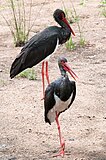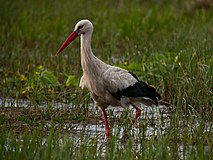List of birds of Great Britain
This list of birds of Great Britain comprises all bird species that have been recorded in a wild state in Great Britain. It follows the official British List, maintained by the British Ornithologists' Union (BOU).[1] Decisions relating to the British List are published by the British Ornithologists' Union Records Committee (BOURC) in its annual reports in the BOU's journal Ibis. These reports were formerly geographically based and included the whole of the British Isles, but records for the Republic of Ireland and Northern Ireland are now published by their own ornithological associations. Records from the Isle of Man are adjudicated by the Manx Ornithological Society.[2]
Bird species admitted to the British List are those in BOU categories A, B or C:
- A: species that have been recorded in an apparently natural state at least once since 1 January 1950.
- B: species that were recorded in an apparently natural state at least once between 1 January 1800 and 31 December 1949, but have not been recorded subsequently.
- C: species that, although originally introduced by humans, either deliberately or accidentally, have established breeding populations derived from introduced stock, which maintain themselves without necessary recourse to further introduction.
Birds can be listed in more than one category: for example, the Canada goose has a large introduced population but there have also been a few naturally occurring vagrants, and the white-tailed eagle is a native species that is also subject to an ongoing reintroduction project, so both species meet the criteria for categories A and C.
Categories D and E (not listed here) are used for record keeping only, and species in these categories are not included in the British List:
- D: species that would otherwise appear in categories A or B except that there is reasonable doubt that they have ever occurred in a natural state.
- E: species that have been recorded as introductions, transportees, or escapees from captivity, and whose breeding populations (if any) are not believed to be self-sustaining.
A further category (not listed here) is being compiled:
- F: species recorded before 1800, including fossil species.[3]
As of 13 August 2024, there are 641 species of birds on the British List, the latest addition being western olivaceous warbler on 20-21 October 2023.[4] Five species groups (birds that were not identified to species level) are included in an appendix to the December 2023 amendment – southern/northern giant petrel (Macronectes giganteus/halli), Fea's/Desertas petrel (Pterodroma feae/desertas), black-bellied/white-bellied storm petrel (Fregetta tropica/grallaria), brown/south polar skua (Stercorarius antarctica/maccormickii), and Asian/Mediterranean/Turkestan short-toed lark (Alaudala cheleensis/rufescens/heinei). A number of additional species are awaiting consideration by the British Ornithologists' Union Records Committee.
Species listed on this page as "rare" are those for which a full description is required for acceptance of the record by the British Birds Rarities Committee. Other species have an indication of their breeding and wintering status in Great Britain.
In general the avifauna of Britain is similar to that of the rest of Europe. Because of its mild winters, Great Britain has a considerable population of wintering species, particularly ducks, geese and swans. There are also a number of species, such as the oystercatcher, that are resident on the island of Great Britain, but migrants elsewhere. Britain receives a number of vagrants from Asia and North America. Some American gulls, ducks and waders are regular enough not to be considered rare, including the ring-billed gull, surf scoter and pectoral sandpiper. There is one endemic bird species found in Great Britain: the Scottish crossbill.
Ducks, geese, and swans
[edit]Order: Anseriformes Family: Anatidae
The swans, ducks and geese are medium to large birds that are adapted to an aquatic existence with webbed feet and bills which are flattened to a greater or lesser extent. In many ducks the male is colourful while the female is dull brown. The diet consists of a variety of animals and plants. The family is well represented in Britain, especially in winter when large numbers visit from Greenland, Scandinavia and Russia.
| Common and binomial names | Image | Status |
|---|---|---|
| Brent goose (Branta bernicla) |
 |
A – winter visitor |
| Red-breasted goose (Branta ruficollis) |
 |
A – rare vagrant |
| Canada goose (Branta canadensis) |
 |
A & C – resident introduced population, some wild vagrants |
| Barnacle goose (Branta leucopsis) |
 |
A & C – winter visitor and resident introduced population |
| Cackling goose (Branta hutchinsii) |
 |
A – rare vagrant |
| Ross's goose (Anser rossii) |
 |
A – rare vagrant[5] |
| Snow goose (Anser caerulescens) |
 |
A & C – some wild vagrants, also a very small feral introduced population |
| Greylag goose (Anser anser) |
 |
A & C – resident wild and feral populations, winter visitor |
| Taiga bean goose (Anser fabalis) |
 |
A – winter visitor |
| Pink-footed goose (Anser brachyrhynchus) |
 |
A – winter visitor |
| Tundra bean goose (Anser serrirostris) |
 |
A – winter visitor |
| White-fronted goose (Anser albifrons) |
 |
A – winter visitor |
| Lesser white-fronted goose (Anser erythropus) |
 |
A – rare vagrant |
| Mute swan (Cygnus olor) |
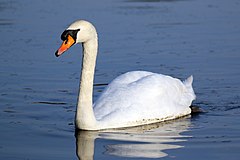 |
A & C – resident breeding species |
| Bewick's swan (Cygnus columbianus) |
 |
A – winter visitor |
| Whooper swan (Cygnus cygnus) |
 |
A – winter visitor and occasional breeder |
| Egyptian goose (Alopochen aegyptiaca) |
 |
C – resident introduced population |
| Shelduck (Tadorna tadorna) |
 |
A – resident breeder and winter visitor |
| Ruddy shelduck (Tadorna ferruginea) |
 |
B – numerous records since 1946 are presumed feral or escapes from captivity |
| Mandarin duck (Aix galericulata) |
 |
C – resident introduced population |
| Baikal teal (Sibirionetta formosa) |
 |
A – rare vagrant |
| Garganey (Spatula querquedula) |
 |
A – breeding summer visitor |
| Blue-winged teal (Spatula discors) |
 |
A – rare vagrant |
| Shoveler (Spatula clypeata) |
 |
A – resident breeder and winter visitor |
| Gadwall (Mareca strepera) |
 |
A & C – resident breeder and winter visitor |
| Falcated duck (Mareca falcata) |
 |
A – rare vagrant |
| Wigeon (Mareca penelope) |
 |
A – resident breeder and winter visitor |
| American wigeon (Mareca americana) |
 |
A – scarce migrant |
| Mallard (Anas platyrhynchos) |
 |
A & C – resident breeder, winter visitor and naturalised releases |
| Black duck (Anas rubripes) |
 |
A – rare vagrant |
| Pintail (Anas acuta) |
 |
A – resident breeder and winter visitor |
| Teal (Anas crecca) |
 |
A – resident breeder and winter visitor |
| Green-winged teal (Anas carolinensis) |
 |
A – scarce migrant |
| Red-crested pochard (Netta rufina) |
 |
A & C – scarce migrant and introduced breeder |
| Canvasback (Aythya valisineria) |
 |
A – rare vagrant |
| Redhead (Aythya americana) |
 |
A – rare vagrant |
| Pochard (Aythya ferina) |
 |
A – resident breeder and winter visitor |
| Ferruginous duck (Aythya nyroca) |
 |
A – scarce migrant |
| Ring-necked duck (Aythya collaris) |
 |
A – scarce migrant |
| Tufted duck (Aythya fuligula) |
 |
A – resident breeder and winter visitor |
| Scaup (Aythya marila) |
 |
A – winter visitor and occasional breeder |
| Lesser scaup (Aythya affinis) |
 |
A – rare vagrant |
| Steller's eider (Polysticta stelleri) |
 |
A – rare vagrant |
| King eider (Somateria spectabilis) |
 |
A – rare vagrant |
| Eider (Somateria mollissima) |
 |
A – resident breeder and winter visitor |
| Harlequin duck (Histrionicus histrionicus) |
 |
A – rare vagrant |
| Surf scoter (Melanitta perspicillata) |
 |
A – scarce migrant |
| Velvet scoter (Melanitta fusca) |
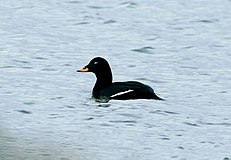 |
A – winter visitor |
| White-winged scoter (Melanitta deglandi) |
 |
A – rare vagrant |
| Stejneger's scoter (Melanitta stejnegeri) |
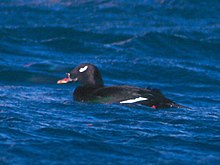 |
A – rare vagrant, first recorded 2022[6] |
| Common scoter (Melanitta nigra) |
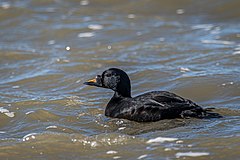 |
A – passage and winter visitor, and rare breeder |
| Black scoter (Melanitta americana) |
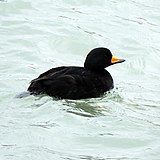 |
A – rare vagrant |
| Long-tailed duck (Clangula hyemalis) |
 |
A – winter visitor and occasional breeder |
| Bufflehead (Bucephala albeola) |
 |
A – rare vagrant |
| Goldeneye (Bucephala clangula) |
 |
A – resident breeder and winter visitor |
| Barrow's goldeneye (Bucephala islandica) |
 |
A – rare vagrant |
| Smew (Mergellus albellus) |
 |
A – winter visitor |
| Hooded merganser (Lophodytes cucullatus) |
 |
A – rare vagrant |
| Goosander (Mergus merganser) |
 |
A – resident breeder and winter visitor |
| Red-breasted merganser (Mergus serrator) |
 |
A – resident breeder and winter visitor |
| Ruddy duck (Oxyura jamaicensis) |
 |
C – introduced species currently subject to an eradication programme |
Pheasants, grouse, and allies
[edit]Order: Galliformes Family: Phasianidae
These are terrestrial species, feeding and nesting on the ground. They are variable in size but generally plump, with broad and relatively short wings. Four of these were introduced for hunting or ornamental purposes but two have now died out.
| Common and binomial names | Image | Status |
|---|---|---|
| Red grouse (Lagopus scotica) |
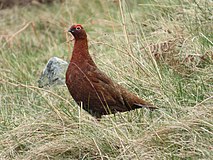 |
A – resident breeding species |
| Ptarmigan (Lagopus muta) |
 |
A – resident breeding species |
| Capercaillie (Tetrao urogallus) |
 |
C – resident reintroduced population |
| Black grouse (Lyrurus tetrix) |
 |
A – resident breeding species |
| Grey partridge (Perdix perdix) |
 |
A & C – resident breeder and introduced gamebird |
| Golden pheasant (Chrysolophus pictus) |
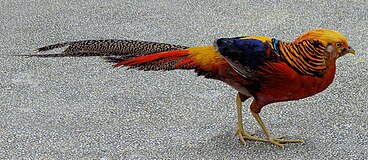 |
C – former introduced population, now died out[7] |
| Lady Amherst's pheasant (Chrysolophus amherstiae) |
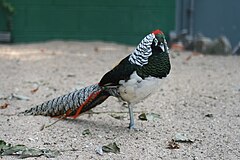 |
C – former introduced population, now died out |
| Pheasant (Phasianus colchicus) |
 |
C – resident introduced population |
| Quail (Coturnix coturnix) |
 |
A – breeding summer visitor |
| Red-legged partridge (Alectoris rufa) |
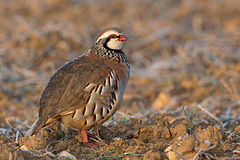 |
C – resident introduced population |
Nightjars and allies
[edit]Order: Caprimulgiformes Family: Caprimulgidae
Nightjars are medium-sized nocturnal birds that usually nest on the ground. They have long wings, short legs and very short bills. Their soft plumage is cryptically coloured to resemble bark or leaves.
| Common and binomial names | Image | Status |
|---|---|---|
| Common nighthawk (Chordeiles minor) |
 |
A – rare vagrant |
| Red-necked nightjar (Caprimulgus ruficollis) |
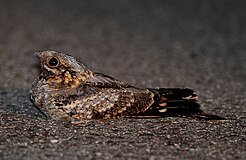 |
B – rare vagrant (one record, 1856) |
| Nightjar (Caprimulgus europaeus) |
 |
A – breeding summer visitor |
| Egyptian nightjar (Caprimulgus aegyptius) |
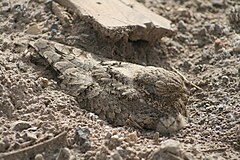 |
A – rare vagrant |
Swifts
[edit]Order: Apodiformes Family: Apodidae The swifts are small birds which spend the majority of their lives flying. These birds have very short legs and never settle voluntarily on the ground, perching instead only on vertical surfaces.
| Common and binomial names | Image | Status |
|---|---|---|
| White-throated needletail (Hirundapus caudacutus) |
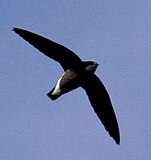 |
A – rare vagrant |
| Chimney swift (Chaetura pelagica) |
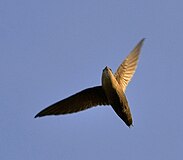 |
A – rare vagrant |
| Alpine swift (Apus melba) |
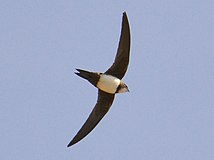 |
A – scarce migrant |
| Swift (Apus apus) |
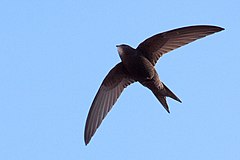 |
A – breeding summer visitor |
| Pallid swift (Apus pallidus) |
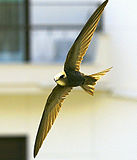 |
A – rare vagrant |
| Pacific swift (Apus pacificus) |
 |
A – rare vagrant |
| Little swift (Apus affinis) |
 |
A – rare vagrant |
| White-rumped swift (Apus caffer) |
 |
A – rare vagrant |
Bustards
[edit]Order: Otidiformes Family: Otididae
Large, sturdy birds of open plains with long legs and necks and strong feet. They are all rarities.
| Common and binomial names | Image | Status |
|---|---|---|
| Great bustard (Otis tarda) |
 |
A – rare vagrant and recently reintroduced breeding resident species |
| MacQueen's bustard (Chlamydotis macqueenii) |
 |
A – rare vagrant; only one record since 1950, in 1962 |
| Little bustard (Tetrax tetrax) |
 |
A – rare vagrant |
Cuckoos
[edit]Order: Cuculiformes Family: Cuculidae
Birds of variable size with slender bodies and long tails. Some species are known for laying their eggs in the nests of other birds.
| Common and binomial names | Image | Status |
|---|---|---|
| Great spotted cuckoo (Clamator glandarius) |
 |
A – rare vagrant |
| Yellow-billed cuckoo (Coccyzus americanus) |
 |
A – rare vagrant |
| Black-billed cuckoo (Coccyzus erythropthalmus) |
 |
A – rare vagrant |
| Cuckoo (Cuculus canorus) |
 |
A – breeding summer visitor |
Sandgrouse
[edit]Order: Pterocliformes Family: Pteroclidae
Sturdy, medium-sized birds with a small head and long, pointed wings.
| Common and binomial names | Image | Status |
|---|---|---|
| Pallas's sandgrouse (Syrrhaptes paradoxus) |
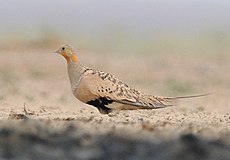 |
A – rare vagrant; has bred |
Pigeons and doves
[edit]Order: Columbiformes Family: Columbidae
Pigeons and doves are stout-bodied birds with short necks and short slender bills with a fleshy cere. There are 344 species worldwide, seven in Britain.
| Common and binomial names | Image | Status |
|---|---|---|
| Rock dove or feral pigeon (Columba livia) |
 |
A & C – resident; most birds are of feral origin; wild birds in far N & W Scotland |
| Stock dove (Columba oenas) |
 |
A – resident breeding species |
| Woodpigeon (Columba palumbus) |
 |
A – resident breeding species |
| Turtle dove (Streptopelia turtur) |
 |
A – breeding summer visitor |
| Oriental turtle dove (Streptopelia orientalis) |
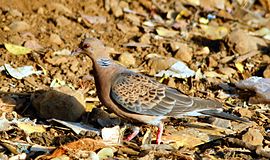 |
A – rare vagrant |
| Collared dove (Streptopelia decaocto) |
 |
A – resident breeding species |
| Mourning dove (Zenaida macroura) |
 |
A – rare vagrant |
Rails, gallinules, and coots
[edit]Order: Gruiformes Family: Rallidae
These birds mainly occupy dense vegetation in damp environments near lakes, marshes or rivers. Many are shy and secretive birds, making them difficult to observe. Most species have strong legs and long toes which are well adapted to soft uneven surfaces.
| Common and binomial names | Image | Status |
|---|---|---|
| Water rail (Rallus aquaticus) |
 |
A – resident breeding species and winter visitor |
| Corncrake (Crex crex) |
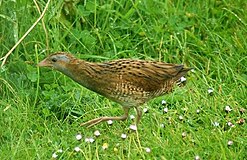 |
A – breeding summer visitor, formerly abundant, now scarce |
| Sora rail (Porzana carolina) |
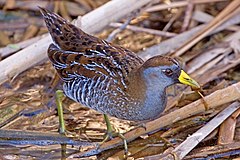 |
A – rare vagrant |
| Spotted crake (Porzana porzana) |
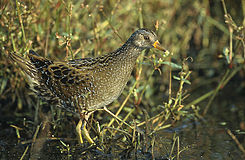 |
A – scarce breeding summer visitor |
| Moorhen (Gallinula chloropus) |
 |
A – resident breeding species |
| Coot (Fulica atra) |
 |
A – resident breeding species and winter visitor |
| American coot (Fulica americana) |
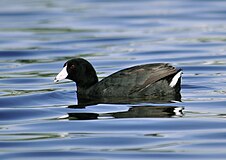 |
A – rare vagrant |
| Allen's gallinule (Porphyrio alleni) |
 |
A – rare vagrant |
| American purple gallinule (Porphyrio martinicus) |
 |
A – rare vagrant |
| Western swamphen[8] (Porphyrio porphyrio) |
 |
A – rare vagrant; first record 2016 |
| Baillon's crake (Zapornia pusilla) |
 |
A – rare vagrant, has bred |
| Little crake (Zapornia parva) |
 |
A – rare vagrant |
Cranes
[edit]Order: Gruiformes Family: Gruidae
Cranes are large, long-legged and long-necked birds. Unlike the similar-looking but unrelated herons, cranes fly with necks outstretched, not pulled back. Most have elaborate and noisy courting displays or "dances".
| Common and binomial names | Image | Status |
|---|---|---|
| Sandhill crane (Antigone canadensis) |
 |
A – rare vagrant |
| Crane (Grus grus) |
 |
A – scarce resident breeding species and passage migrant |
Grebes
[edit]Order: Podicipediformes Family: Podicipedidae
Grebes are small to medium-large diving birds with lobed toes and pointed bills. They are seen mainly on lowland waters and coasts. They feed on aquatic animals and nest on a floating platform of vegetation.
| Common and binomial names | Image | Status |
|---|---|---|
| Little grebe (Tachybaptus ruficollis) |
 |
A – resident breeder and winter visitor |
| Pied-billed grebe (Podilymbus podiceps) |
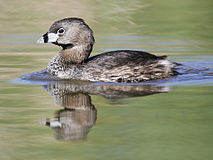 |
A – rare vagrant; has hybridised with Little grebe once |
| Red-necked grebe (Podiceps grisegena) |
 |
A – winter visitor; has bred |
| Great crested grebe (Podiceps cristatus) |
 |
A – resident breeder and winter visitor |
| Slavonian grebe (Podiceps auritus) |
 |
A – scarce resident breeder and winter visitor |
| Black-necked grebe (Podiceps nigricollis) |
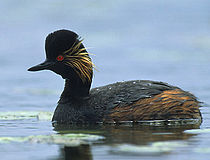 |
A – scarce resident breeder and winter visitor |
Stone-curlews
[edit]Order: Charadriiformes Family: Burhinidae
A small family of medium to large waders with strong black bills, large yellow eyes and cryptic plumage.
| Common and binomial names | Image | Status |
|---|---|---|
| Stone-curlew (Burhinus oedicnemus) |
 |
A – scarce breeding summer visitor |
Oystercatchers
[edit]Order: Charadriiformes Family: Haematopodidae
The oystercatchers are large, obvious and noisy wading birds with strong bills used for smashing or prising open molluscs. There are eleven species worldwide with one in Britain.
| Common and binomial names | Image | Status |
|---|---|---|
| Oystercatcher (Haematopus ostralegus) |
 |
A – resident breeding species, passage migrant, and winter visitor |
Stilts and avocets
[edit]Order: Charadriiformes Family: Recurvirostridae
A family of fairly large wading birds. The avocets have long legs and long up-curved bills. The stilts have extremely long legs and long, thin, straight bills. There are ten species worldwide with two in Britain.
| Common and binomial names | Image | Status |
|---|---|---|
| Black-winged stilt (Himantopus himantopus) |
 |
A – scarce migrant and occasional breeder |
| Avocet (Recurvirostra avosetta) |
 |
A – resident breeding species |
Plovers and lapwings
[edit]Order: Charadriiformes Family: Charadriidae
Small to medium-sized wading birds with compact bodies, short, thick necks and long, usually pointed, wings.
| Common and binomial names | Image | Status |
|---|---|---|
| Grey plover (Pluvialis squatarola) |
 |
A – winter visitor and passage migrant |
| Golden plover (Pluvialis apricaria) |
 |
A – breeding resident, passage migrant, and winter visitor |
| Pacific golden plover (Pluvialis fulva) |
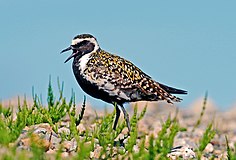 |
A – rare vagrant |
| American golden plover (Pluvialis dominica) |
 |
A – scarce migrant |
| Dotterel (Eudromias morinellus) |
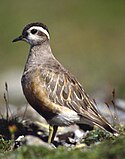 |
A – passage migrant and breeding summer visitor |
| Killdeer (Charadrius vociferus) |
 |
A – rare vagrant |
| Ringed plover (Charadrius hiaticula) |
 |
A – resident breeding species and passage and winter visitor |
| Semipalmated plover (Charadrius semipalmatus) |
 |
A – rare vagrant |
| Little ringed plover (Charadrius dubius) |
 |
A – breeding summer visitor |
| Lapwing (Vanellus vanellus) |
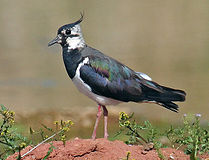 |
A – resident breeding species, passage migrant, and winter visitor |
| Grey-headed lapwing (Vanellus cinereus) |
 |
A – rare vagrant; first recorded May 2023 |
| Sociable lapwing (Vanellus gregarius) |
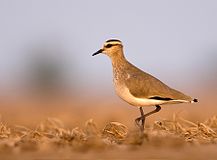 |
A – rare vagrant |
| White-tailed lapwing (Vanellus leucurus) |
 |
A – rare vagrant |
| Caspian plover (Anarhynchus asiaticus) |
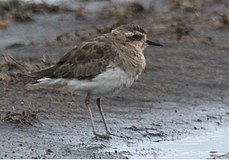 |
A – rare vagrant |
| Tibetan sand plover (Anarhynchus atrifrons) |
 |
A – rare vagrant |
| Siberian sand plover (Anarhynchus mongolus) |
 |
A – rare vagrant |
| Greater sand plover (Anarhynchus leschenaultii) |
 |
A – rare vagrant |
| Kentish plover (Anarhynchus alexandrinus) |
 |
A – former breeder, now rare vagrant |
Sandpipers and allies
[edit]Order: Charadriiformes Family: Scolopacidae
A large, diverse family of wading birds. Different lengths of legs and bills enable multiple species to feed in the same habitat, particularly on the coast, without direct competition for food.
| Common and binomial names | Image | Status |
|---|---|---|
| Upland sandpiper (Bartramia longicauda) |
 |
A – rare vagrant |
| Whimbrel (Numenius phaeopus) |
 |
A – passage migrant and scarce breeding summer visitor in far north |
| Hudsonian whimbrel (Numenius hudsonicus) |
 |
A – rare vagrant |
| Little whimbrel (Numenius minutus) |
 |
A – rare vagrant |
| Eskimo curlew (Numenius borealis) |
 --> --> |
B – extinct |
| Curlew (Numenius arquata) |
 |
A – resident breeding species |
| Bar-tailed godwit (Limosa lapponica) |
 |
A – winter visitor and passage migrant |
| Black-tailed godwit (Limosa limosa) |
 |
A – winter visitor, passage migrant and scarce summer breeding species |
| Hudsonian godwit (Limosa haemastica) |
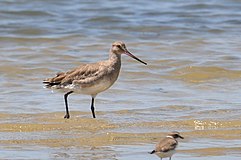 |
A – rare vagrant |
| Turnstone (Arenaria interpres) |
 |
A – winter visitor and passage migrant |
| Great knot (Calidris tenuirostris) |
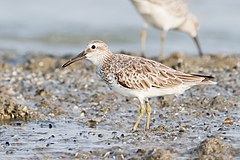 |
A – rare vagrant |
| Knot (Calidris canutus) |
 |
A – winter visitor and passage migrant |
| Ruff (Calidris pugnax) |
 |
A – passage migrant and winter visitor, also a former scarce breeding resident |
| Broad-billed sandpiper (Calidris falcinellus) |
 |
A – rare vagrant |
| Sharp-tailed sandpiper (Calidris acuminata) |
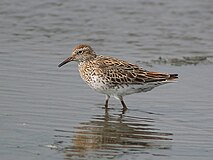 |
A – rare vagrant |
| Stilt sandpiper (Calidris himantopus) |
 |
A – rare vagrant |
| Curlew sandpiper (Calidris ferruginea) |
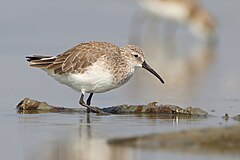 |
A – passage migrant, rarely also wintering |
| Temminck's stint (Calidris temminckii) |
 |
A – scarce passage migrant, occasional breeder |
| Long-toed stint (Calidris subminuta) |
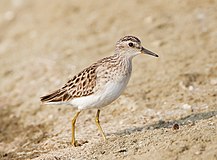 |
A – rare vagrant |
| Red-necked stint (Calidris ruficollis) |
 |
A – rare vagrant |
| Sanderling (Calidris alba) |
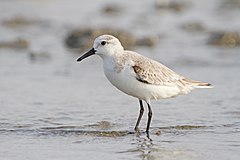 |
A – winter visitor and passage migrant |
| Dunlin (Calidris alpina) |
 |
A – winter visitor and passage migrant, scarce breeder |
| Purple sandpiper (Calidris maritima) |
 |
A – winter visitor and passage migrant, occasional breeder |
| Baird's sandpiper (Calidris bairdii) |
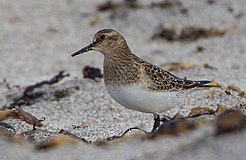 |
A – rare vagrant |
| Little stint (Calidris minuta) |
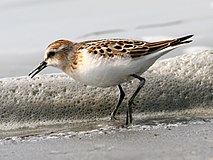 |
A – passage migrant, rarely also wintering |
| Least sandpiper (Calidris minutilla) |
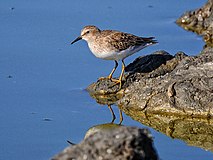 |
A – rare vagrant |
| White-rumped sandpiper (Calidris fuscicollis) |
 |
A – scarce passage migrant |
| Buff-breasted sandpiper (Calidris subruficollis) |
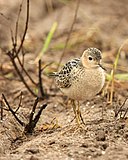 |
A – scarce passage migrant |
| Pectoral sandpiper (Calidris melanotos) |
 |
A – scarce passage migrant |
| Semipalmated sandpiper (Calidris pusilla) |
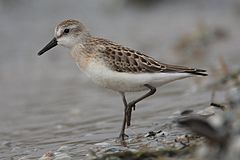 |
A – rare vagrant |
| Western sandpiper (Calidris mauri) |
 |
A – rare vagrant |
| Long-billed dowitcher (Limnodromus scolopaceus) |
 |
A – rare vagrant |
| Short-billed dowitcher (Limnodromus griseus) |
 |
A – rare vagrant |
| Woodcock (Scolopax rusticola) |
 |
A – resident breeding species |
| Jack snipe (Lymnocryptes minimus) |
 |
A – winter visitor and passage migrant |
| Great snipe (Gallinago media) |
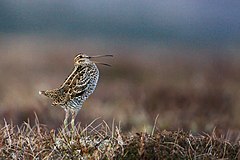 |
A – rare vagrant |
| Snipe (Gallinago gallinago) |
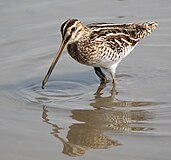 |
A – resident breeding species and winter visitor |
| Wilson's snipe (Gallinago delicata) |
 |
A – rare vagrant |
| Terek sandpiper (Xenus cinereus) |
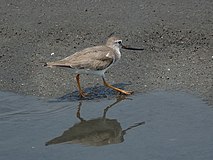 |
A – rare vagrant |
| Wilson's phalarope (Phalaropus tricolor) |
 |
A – rare vagrant |
| Red-necked phalarope (Phalaropus lobatus) |
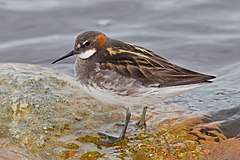 |
A – winter visitor: scarce and localised summer breeding in far North |
| Grey phalarope (Phalaropus fulicaria) |
 |
A – scarce winter visitor |
| Common sandpiper (Actitis hypoleucos) |
 |
A – resident breeding species and passage migrant |
| Spotted sandpiper (Actitis macularius) |
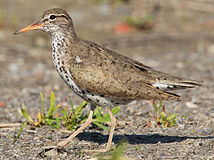 |
A – rare vagrant |
| Green sandpiper (Tringa ochropus) |
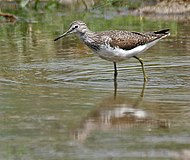 |
A – winter visitor and passage migrant, occasional breeder |
| Solitary sandpiper (Tringa solitaria) |
 |
A – rare vagrant |
| Grey-tailed tattler (Tringa brevipes) |
 |
A – rare vagrant |
| Lesser yellowlegs (Tringa flavipes) |
 |
A – scarce migrant, formerly a rare vagrant[9] |
| Redshank (Tringa totanus) |
 |
A – resident breeding species |
| Marsh sandpiper (Tringa stagnatilis) |
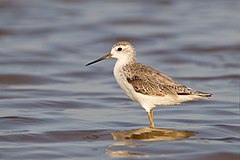 |
A – rare vagrant |
| Wood sandpiper (Tringa glareola) |
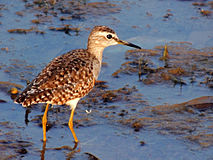 |
A – passage migrant and rare localised breeder in far North |
| Spotted redshank (Tringa erythropus) |
 |
A – winter visitor and passage migrant |
| Greenshank (Tringa nebularia) |
 |
A – resident breeding species and passage migrant |
| Greater yellowlegs (Tringa melanoleuca) |
 |
A – rare vagrant |
Pratincoles and coursers
[edit]Order: Charadriiformes Family: Glareolidae
A family of slender, long-winged wading birds.
| Common and binomial names | Image | Status |
|---|---|---|
| Cream-coloured courser (Cursorius cursor) |
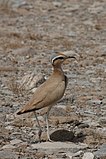 |
A – rare vagrant |
| Collared pratincole (Glareola pratincola) |
 |
A – rare vagrant |
| Oriental pratincole (Glareola maldivarum) |
 |
A – rare vagrant |
| Black-winged pratincole (Glareola nordmanni) |
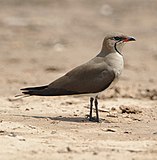 |
A – rare vagrant |
Gulls, terns, and skimmers
[edit]Order: Charadriiformes Family: Laridae
Medium to large seabirds with grey, white and black plumage, webbed feet and strong bills. Many are opportunistic and adaptable feeders.
| Common and binomial names | Image | Status |
|---|---|---|
| Kittiwake (Rissa tridactyla) |
 |
A – breeding summer visitor and resident species |
| Ivory gull (Pagophila eburnea) |
 |
A – rare vagrant |
| Sabine's gull (Xema sabini) |
 |
A – scarce winter visitor |
| Slender-billed gull (Chroicocephalus genei) |
 |
A – rare vagrant |
| Bonaparte's gull (Chroicocephalus philadelphia) |
 |
A – rare vagrant |
| Black-headed gull (Chroicocephalus ridibundus) |
 |
A – resident breeding species |
| Little gull (Hydrocoloeus minutus) |
 |
A – winter visitor, occasional breeder |
| Ross's gull (Rhodostethia rosea) |
 |
A – rare vagrant |
| Laughing gull (Leucophaeus atricilla) |
 |
A – rare vagrant |
| Franklin's gull (Leucophaeus pipixcan) |
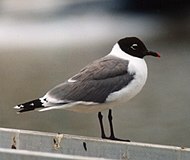 |
A – rare vagrant |
| Audouin's gull (Ichthyaetus audouinii) |
 |
A – rare vagrant |
| Mediterranean gull (Ichthyaetus melanocephalus) |
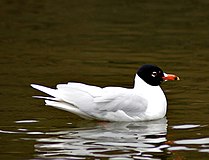 |
A – breeding summer visitor, and resident in south. |
| Great black-headed gull (Ichthyaetus ichthyaetus) |
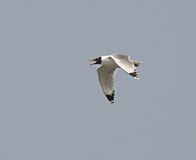 |
B – rare vagrant (one record, 1859) |
| Common gull (Larus canus) |
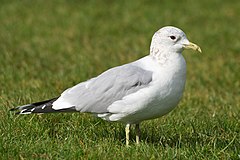 |
A – resident breeding species, winter visitor and passage migrant |
| Ring-billed gull (Larus delawarensis) |
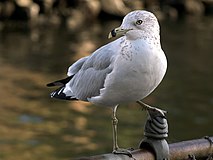 |
A – scarce winter visitor and passage migrant |
| Great black-backed gull (Larus marinus) |
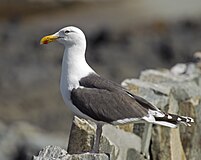 |
A – resident breeding species and passage migrant |
| Kelp gull (Larus dominicanus) |
 |
A – rare vagrant; first recorded 2022[10][11] |
| Glaucous-winged gull (Larus glaucescens) |
 |
A – rare vagrant |
| Glaucous gull (Larus hyperboreus) |
 |
A – winter visitor; has bred |
| Iceland gull (Larus glaucoides) |
 |
A – scarce winter visitor |
| European herring gull (Larus argentatus) |
 |
A – resident breeding species |
| American herring gull (Larus smithsonianus) |
 |
A – rare vagrant |
| Caspian gull (Larus cachinnans) |
 |
A – scarce migrant |
| Yellow-legged gull (Larus michahellis) |
 |
A – scarce visitor and passage migrant; has bred[12] |
| Slaty-backed gull (Larus schistisagus) |
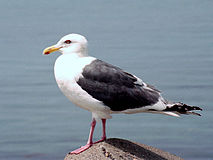 |
A – rare vagrant |
| Lesser black-backed gull (Larus fuscus) |
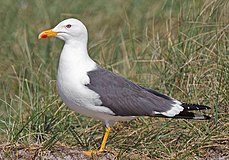 |
A – resident breeding species and passage migrant |
| Gull-billed tern (Gelochelidon nilotica) |
 |
A – rare vagrant; has bred |
| Caspian tern (Hydroprogne caspia) |
 |
A – rare vagrant |
| Royal tern (Thalasseus maximus) |
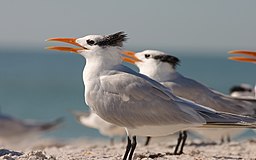 |
A – rare vagrant |
| Lesser crested tern (Thalasseus bengalensis) |
 |
A – rare vagrant |
| Sandwich tern (Thalasseus sandvicensis) |
 |
A – breeding summer visitor |
| Cabot's tern (Thalasseus acuflavida) |
 |
A – rare vagrant |
| Elegant tern (Thalasseus elegans) |
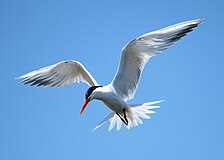 |
A – rare vagrant |
| Little tern (Sternula albifrons) |
 |
A – breeding summer visitor |
| Least tern (Sternula antillarum) |
 |
A – rare vagrant |
| Aleutian tern (Onychoprion aleutica) |
 |
A – rare vagrant |
| Bridled tern (Onychoprion anaethetus) |
 |
A – rare vagrant |
| Sooty tern (Onychoprion fuscata) |
 |
A – rare vagrant |
| Roseate tern (Sterna dougallii) |
 |
A – scarce breeding summer visitor |
| Common tern (Sterna hirundo) |
 |
A – breeding summer visitor |
| Arctic tern (Sterna paradisaea) |
 |
A – breeding summer visitor |
| Forster's tern (Sterna forsteri) |
 |
A – rare vagrant |
| Whiskered tern (Chlidonias hybridus) |
 |
A – rare vagrant |
| White-winged black tern (Chlidonias leucopterus) |
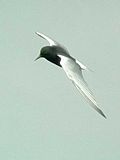 |
A – scarce migrant |
| Black tern (Chlidonias niger) |
 |
A – passage migrant, occasional breeder |
Skuas
[edit]Order: Charadriiformes Family: Stercorariidae
Medium to large seabirds with mainly grey or brown plumage, sharp claws and a hooked tip to the bill. They chase other seabirds to force them to drop their catches.
| Common and binomial names | Image | Status |
|---|---|---|
| South polar skua (Stercorarius maccormicki) |
 |
A – rare vagrant[13] |
| Great skua (Stercorarius skua) |
 |
A – passage migrant and localised summer breeder |
| Pomarine skua (Stercorarius pomarinus) |
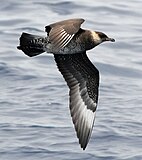 |
A – passage migrant |
| Arctic skua (Stercorarius parasiticus) |
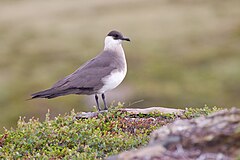 |
A – passage migrant and localised summer breeder |
| Long-tailed skua (Stercorarius longicaudus) |
 |
A – passage migrant |
Auks, murres, and puffins
[edit]Order: Charadriiformes Family: Alcidae
A family of seabirds which are superficially similar to penguins, with their black-and-white colours, upright posture and some of their habits, but which are able to fly.
| Common and binomial names | Image | Status |
|---|---|---|
| Little auk (Alle alle) |
 |
A – rare winter visitor |
| Brünnich's guillemot (Uria lomvia) |
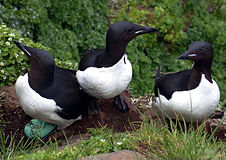 |
A – rare vagrant |
| Common guillemot (Uria aalge) |
 |
A – breeding summer visitor and resident species |
| Razorbill (Alca torda) |
 |
A – breeding summer visitor and resident species |
| Great auk (Pinguinus impennis) |
 |
B – extinct |
| Black guillemot (Cepphus grylle) |
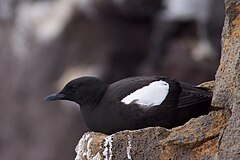 |
A – resident localised breeding species |
| Long-billed murrelet (Brachyramphus perdix) |
 |
A – rare vagrant |
| Ancient murrelet (Synthliboramphus antiquus) |
 |
A – rare vagrant |
| Puffin (Fratercula arctica) |
 |
A – breeding summer visitor |
| Tufted puffin (Fratercula cirrhata) |
 |
A – rare vagrant |
Tropicbirds
[edit]Order: Phaethontiformes Family: Phaethontidae
Tropicbirds are slender white birds of tropical oceans, with exceptionally long central tail feathers. Their heads and long wings have black markings.
| Common and binomial names | Image | Status |
|---|---|---|
| Red-billed tropicbird (Phaethon aethereus) |
 |
A – rare vagrant |
Divers
[edit]Order: Gaviiformes Family: Gaviidae
Divers are aquatic birds the size of a large duck, to which they are unrelated. They swim well and fly adequately but are almost helpless on land, because their legs are placed towards the rear of the body. They feed on fish and other aquatic animals.
| Common and binomial names | Image | Status |
|---|---|---|
| Red-throated diver (Gavia stellata) |
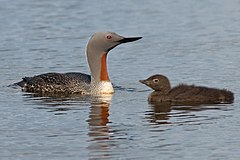 |
A – resident breeder and winter visitor |
| Black-throated diver (Gavia arctica) |
 |
A – resident breeder and winter visitor |
| Pacific diver (Gavia pacifica) |
 |
A – rare vagrant |
| Great northern diver (Gavia immer) |
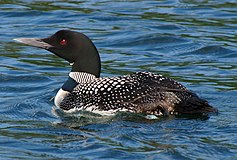 |
A – winter visitor; has bred |
| White-billed diver (Gavia adamsii) |
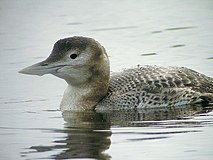 |
A – rare vagrant |
Southern storm petrels
[edit]Order: Procellariiformes Family: Oceanitidae
The southern storm petrels are the smallest seabirds, feeding on plankton and small fish picked from the surface, typically while hovering. They nest in colonies on the ground, most often in burrows.
| Common and binomial names | Image | Status |
|---|---|---|
| Wilson's storm petrel (Oceanites oceanicus) |
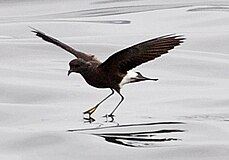 |
A – rare vagrant, more regularly seen well offshore |
| White-faced storm petrel (Pelagodroma marina) |
 |
A – rare vagrant |
Albatrosses
[edit]Order: Procellariiformes Family: Diomedeidae
The albatrosses are among the largest flying birds, with long, narrow wings for gliding. The majority are found in the Southern Hemisphere with only vagrants occurring in the North Atlantic.
| Common and binomial names | Image | Status |
|---|---|---|
| Black-browed albatross (Thalassarche melanophris) |
 |
A – rare vagrant |
| Atlantic yellow-nosed albatross (Thalassarche chlororhynchos) |
 |
A – rare vagrant |
Northern storm petrels
[edit]Order: Procellariiformes Family: Hydrobatidae
The northern storm-petrels are the smallest seabirds, feeding on plankton and small fish picked from the surface, typically while hovering. They nest in colonies on the ground, most often in burrows.
| Common and binomial names | Image | Status |
|---|---|---|
| Storm petrel (Hydrobates pelagicus) |
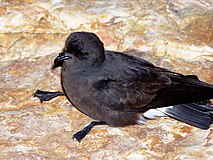 |
A – breeding summer visitor |
| Swinhoe's petrel (Hydrobates monorhis) |
 |
A – rare vagrant |
| Leach's petrel (Hydrobates leucorhous) |
 |
A – breeding summer visitor |
| Madeiran petrel (Hydrobates castro) |
 |
A – rare vagrant; first recorded 2021, with a geotagged bird from a Tenerife breeding colony entering UK waters about 285 km southwest of Bishop Rock, Isles of Scilly |
Shearwaters and petrels
[edit]Order: Procellariiformes Family: Procellariidae
These are highly pelagic birds with long, narrow wings and tube-shaped nostrils. They feed at sea on fish, squid and other marine life. They come to land to breed in colonies, nesting in burrows or on cliffs.
| Common and binomial names | Image | Status |
|---|---|---|
| Fulmar (Fulmarus glacialis) |
 |
A – resident and migrant breeder, passage migrant |
| Soft-plumaged petrel (Pterodroma mollis) |
 |
A – rare vagrant; first recorded 2021 |
| Zino's petrel (Pterodroma madeira) |
 |
A – rare vagrant; first recorded 2020[14][15] |
| Black-capped petrel (Pterodroma hasitata) |
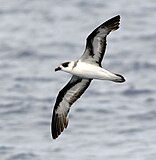 |
B – rare vagrant |
| White-chinned petrel (Procellaria aequinoctialis) |
 |
A – rare vagrant; first recorded 2020 |
| Scopoli's shearwater (Calonectris diomedea) |
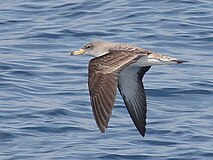 |
A – rare vagrant |
| Cory's shearwater (Calonectris borealis) |
 |
A – scarce migrant |
| Sooty shearwater (Ardenna grisea) |
 |
A – passage migrant |
| Great shearwater (Ardenna gravis) |
 |
A – passage migrant |
| Manx shearwater (Puffinus puffinus) |
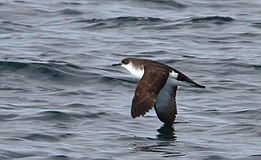 |
A – breeding summer visitor |
| Yelkouan shearwater (Puffinus yelkouan) |
 |
A – rare vagrant |
| Balearic shearwater (Puffinus mauretanicus) |
 |
A – passage migrant |
| Barolo shearwater (Puffinus baroli) |
 |
A – rare vagrant |
Storks
[edit]Order: Ciconiiformes Family: Ciconiidae
Storks are large, heavy, long-legged, long-necked wading birds with long stout bills and wide wingspans. They fly with the neck extended.
| Common and binomial names | Image | Status |
|---|---|---|
| Black stork (Ciconia nigra) |
A – rare vagrant | |
| White stork (Ciconia ciconia) |
A – scarce migrant, formerly bred. Birds from a reintroduced population bred at Knepp Wildland in 2020. |
Frigatebirds
[edit]Order: Suliformes Family: Fregatidae
Frigatebirds are large seabirds usually found over tropical oceans. They are large, black-and-white, or completely black, with long wings and deeply forked tails. The males have colored inflatable throat pouches. They do not swim or walk and cannot take off from a flat surface. Having the largest wingspan-to-body-weight ratio of any bird, they are essentially aerial, able to stay aloft for more than a week.
| Common and binomial names | Image | Status |
|---|---|---|
| Ascension frigatebird (Fregata aquila) |
 |
A – rare vagrant |
| Magnificent frigatebird (Fregata magnificens) |
 |
A – rare vagrant |
Boobies and gannets
[edit]Order: Suliformes Family: Sulidae
Gannets are large seabirds that plunge-dive for fish and nest in large colonies. They have a torpedo-shaped body, long, narrow, pointed wings and a fairly long tail. There are ten species worldwide with three in Britain.
| Common and binomial names | Image | Status |
|---|---|---|
| Gannet (Morus bassanus) |
 |
A – breeding summer visitor and passage migrant |
| Red-footed booby (Sula sula) |
 |
A – rare vagrant |
| Brown booby (Sula leucogaster) |
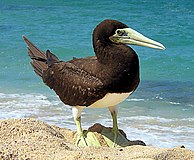 |
A – rare vagrant; first recorded 2019[16] |
Cormorants and shag
[edit]Order: Suliformes Family: Phalacrocoracidae
Cormorants are medium to large aquatic birds with mainly dark plumage and areas of coloured skin on the face. The bill is long, thin and sharply hooked for catching fish and aquatic invertebrates. They nest in colonies by water, usually by the sea or on the banks of rivers.
| Common and binomial names | Image | Status |
|---|---|---|
| Cormorant (Phalacrocorax carbo) |
 |
A – resident breeding species |
| Shag (Gulosus aristotelis) |
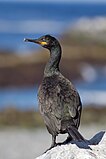 |
A – resident breeding species |
| Double-crested cormorant (Nannopterum auritum) |
 |
A – rare vagrant |
Ibises and spoonbills
[edit]Order: Pelecaniformes Family: Threskiornithidae
A family of long-legged, long-necked wading birds. Ibises have long, curved bills. Spoonbills have a flattened bill, wider at the tip.
| Common and binomial names | Image | Status |
|---|---|---|
| Glossy ibis (Plegadis falcinellus) |
 |
A – scarce migrant, formerly a rare vagrant;[9] has bred[17] |
| Spoonbill (Platalea leucorodia) |
 |
A – scarce migrant, recently bred |
Bitterns, herons and egrets
[edit]Order: Pelecaniformes Family: Ardeidae
Herons and egrets are medium to large wading birds with long necks and legs. Bitterns tend to be shorter-necked and more secretive. They all fly with their necks retracted. The sharp bill is used to catch fish, amphibians and other animals. Many species nest in colonies, often in trees. There are 64 species worldwide and 15 in Britain.
| Common and binomial names | Image | Status |
|---|---|---|
| Bittern (Botaurus stellaris) |
 |
A – resident breeding species and winter migrant |
| American bittern (Botaurus lentiginosus) |
 |
A – rare vagrant |
| Least bittern (Ixobrychus exilis) |
 |
A – rare vagrant; first recorded 2022[18][11] |
| Little bittern (Ixobrychus minutus) |
 |
A – scarce migrant, recently bred |
| Night-heron (Nycticorax nycticorax) |
 |
A – scarce migrant, has bred |
| Green heron (Butorides virescens) |
 |
A – rare vagrant |
| Squacco heron (Ardeola ralloides) |
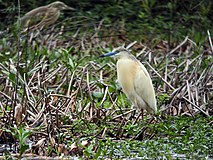 |
A – rare vagrant |
| Chinese pond heron (Ardeola bacchus) |
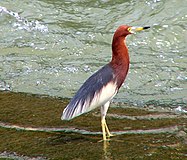 |
A – rare vagrant |
| Cattle egret (Bubulcus ibis) |
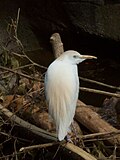 |
A – scarce but increasing breeding resident |
| Grey heron (Ardea cinerea) |
 |
A – resident breeding species and winter migrant |
| Great blue heron (Ardea herodias) |
 |
A – rare vagrant |
| Purple heron (Ardea purpurea) |
 |
A – scarce migrant, recently bred |
| Great white egret (Ardea alba) |
 |
A – resident breeding species, first bred 2012 |
| Snowy egret (Egretta thula) |
 |
A – rare vagrant |
| Little egret (Egretta garzetta) |
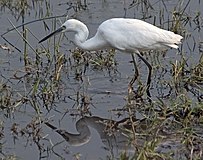 |
A – resident breeding species and passage migrant |
Pelicans
[edit]Order: Pelecaniformes Family: Pelecanidae
Pelicans are large water birds with a distinctive pouch under their beak. As with other members of the order Pelecaniformes, they have webbed feet with four toes.
| Common and binomial names | Image | Status |
|---|---|---|
| Dalmatian pelican (Pelecanus crispus) |
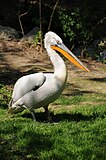 |
A – very rare migrant[19] |
Osprey
[edit]Order: Accipitriformes Family: Pandionidae
A large fish-eating bird of prey belonging to a family of its own. It is mainly brown above and white below with long, angled wings.
| Common and binomial names | Image | Status |
|---|---|---|
| Osprey (Pandion haliaetus) |
 |
A – breeding summer visitor |
Hawks, eagles, and kites
[edit]Order: Accipitriformes Family: Accipitridae
A family of birds of prey which includes hawks, buzzards, eagles, kites and harriers. These birds have very large powerful hooked beaks for tearing flesh from their prey, strong legs, powerful talons and keen eyesight.
| Common and binomial names | Image | Status |
|---|---|---|
| Black-winged Kite (Elanus caeruleus) |
 |
A – rare vagrant; first recorded April 2023 |
| Egyptian vulture (Neophron percnopterus) |
 |
B – rare vagrant; last record 1868 |
| Honey-buzzard (Pernis apivorus) |
 |
A – breeding summer visitor and passage migrant |
| Short-toed eagle (Circaetus gallicus) |
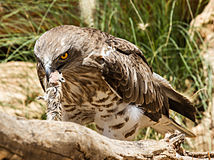 |
A – rare vagrant |
| Spotted eagle (Clanga clanga) |
 |
B – rare vagrant; last record 1915 |
| Golden eagle (Aquila chrysaetos) |
 |
A – resident breeding species |
| Sparrowhawk (Accipiter nisus) |
 |
A – resident breeder and passage migrant |
| Goshawk (Accipiter gentilis) |
 |
A & C – resident breeder and naturalised escapes |
| Marsh harrier (Circus aeruginosus) |
 |
A – resident breeder and passage migrant |
| Hen harrier (Circus cyaneus) |
 |
A – resident breeder, winter visitor and passage migrant |
| Northern harrier (Circus hudsonius) |
 |
A – rare vagrant |
| Pallid harrier (Circus macrourus) |
 |
A – rare vagrant |
| Montagu's harrier (Circus pygargus) |
 |
A – breeding summer visitor and passage migrant |
| Red kite (Milvus milvus) |
 |
A & C – resident breeder and widespread introductions |
| Black kite (Milvus migrans) |
 |
A – scarce migrant |
| White-tailed eagle (Haliaeetus albicilla) |
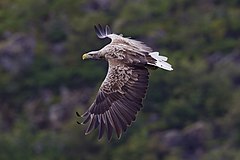 |
A & C – resident breeder; reintroduction projects underway and ongoing |
| Rough-legged buzzard (Buteo lagopus) |
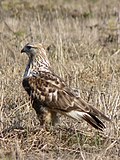 |
A – winter visitor |
| Buzzard (Buteo buteo) |
 |
A – resident breeder and passage migrant |
Barn owls
[edit]Order: Strigiformes Family: Tytonidae
Barn owls are medium to large owls with large heads and characteristic heart-shaped faces. They have long strong legs with powerful talons.
| Common and binomial names | Image | Status |
|---|---|---|
| Western barn owl (Tyto alba) |
 |
A – resident breeding species |
Owls
[edit]Order: Strigiformes Family: Strigidae
Typical owls are small to large solitary nocturnal birds of prey. They have large forward-facing eyes and ears, a hawk-like beak and a conspicuous circle of feathers around each eye called a facial disc.
| Common and binomial names | Image | Status |
|---|---|---|
| Tengmalm's owl (Aegolius funereus) |
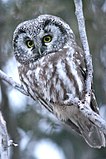 |
A – rare vagrant |
| Little owl (Athene noctua) |
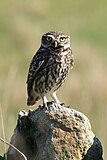 |
C – resident introduced population |
| Hawk owl (Surnia ulula) |
 |
A – rare vagrant |
| Scops owl (Otus scops) |
 |
A – rare vagrant |
| Long-eared owl (Asio otus) |
 |
A – scarce resident breeding species |
| Short-eared owl (Asio flammeus) |
 |
A – resident breeding species or winter visitor |
| Snowy owl (Bubo scandiacus) |
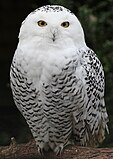 |
A – rare vagrant; has bred Shetland Islands |
| Tawny owl (Strix aluco) |
 |
A – resident breeding species |
Hoopoe
[edit]Order: Bucerotiformes Family: Upupidae
A small family with a long curved bills, crests and black-and-white striped wings and tails.
| Common and binomial names | Image | Status |
|---|---|---|
| Eurasian hoopoe (Upupa epops) |
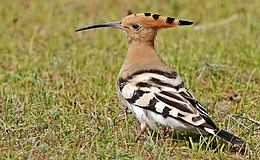 |
A – scarce summer visitor, occasional breeder |
Rollers
[edit]Order: Coraciiformes Family: Coraciidae
A small family of colourful, medium-sized birds with a crow-like shape that feed mainly on insects.
| Common and binomial names | Image | Status |
|---|---|---|
| European roller (Coracias garrulus) |
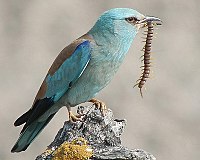 |
A – rare vagrant |
Kingfishers
[edit]Order: Coraciiformes Family: Alcedinidae
Kingfishers are medium-sized birds with large heads, long pointed bills, short legs and stubby tails.
| Common and binomial names | Image | Status |
|---|---|---|
| Kingfisher (Alcedo atthis) |
 |
A – resident breeding species |
| Belted kingfisher (Megaceryle alcyon) |
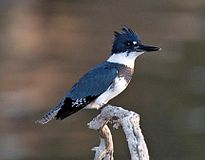 |
A – rare vagrant |
Bee-eaters
[edit]Order: Coraciiformes Family: Meropidae
A group of near-passerine birds characterised by richly coloured plumage, slender bodies and usually elongated central tail-feathers.
| Common and binomial names | Image | Status |
|---|---|---|
| Blue-cheeked bee-eater (Merops persicus) |
 |
A – rare vagrant |
| Bee-eater (Merops apiaster) |
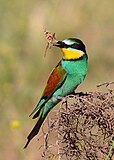 |
A – scarce summer visitor; occasional breeder |
Woodpeckers
[edit]Order: Piciformes Family: Picidae
Woodpeckers are small to medium-sized birds with chisel-like beaks, short legs, stiff tails and long tongues used for capturing insects. Many woodpeckers have the habit of tapping noisily on tree trunks with their beaks.
| Common and binomial names | Image | Status |
|---|---|---|
| Wryneck (Jynx torquilla) |
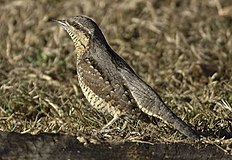 |
A – rare passage migrant; occasional breeder |
| Yellow-bellied sapsucker (Sphyrapicus varius) |
 |
A – rare vagrant |
| Lesser spotted woodpecker (Dryobates minor) |
 |
A – resident breeding species |
| Great spotted woodpecker (Dendrocopos major) |
 |
A – resident breeding species |
| Green woodpecker (Picus viridis) |
 |
A – resident breeding species |
Falcons and caracaras
[edit]Order: Falconiformes Family: Falconidae
A family of small to medium-sized, diurnal birds of prey with pointed wings. They do not build their own nests and mainly catch prey in the air.
| Common and binomial names | Image | Status |
|---|---|---|
| Lesser kestrel (Falco naumanni) |
 |
A – rare vagrant |
| Kestrel (Falco tinnunculus) |
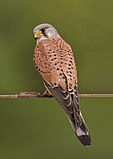 |
A – resident breeding species |
| American kestrel (Falco sparverius) |
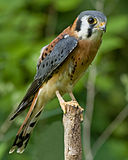 |
A – rare vagrant |
| Red-footed falcon (Falco vespertinus) |
 |
A – scarce migrant |
| Amur falcon (Falco amurensis) |
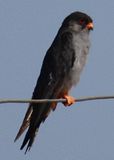 |
A – rare vagrant |
| Eleonora's falcon (Falco eleonorae) |
 |
A – rare vagrant |
| Merlin (Falco columbarius) |
 |
A – resident breeding species |
| Hobby (Falco subbuteo) |
 |
A – breeding summer visitor |
| Gyr falcon (Falco rusticolus) |
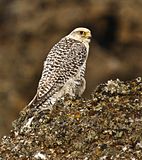 |
A – rare vagrant |
| Peregrine (Falco peregrinus) |
 |
A – resident breeding species |
Parrots
[edit]Order: Psittaciformes Family: Psittaculidae
Parrots are small to large birds with a characteristic curved beak shape. They are found mainly in areas with warm climates.
| Common and binomial names | Image | Status |
|---|---|---|
| Ring-necked parakeet (Psittacula krameri) |
 |
C – resident introduced population |
Tyrant flycatchers
[edit]Order: Passeriformes Family: Tyrannidae
A large family from the Americas.
| Common and binomial names | Image | Status |
|---|---|---|
| Eastern phoebe (Sayornis phoebe) |
 |
A – rare vagrant |
| Yellow-bellied flycatcher (Empidonax flaviventris) |
 |
A – rare vagrant; first recorded 2020[20] |
| Acadian flycatcher (Empidonax virescens) |
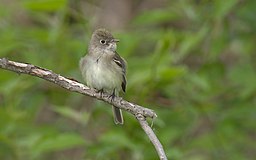 |
A – rare vagrant |
| Alder flycatcher (Empidonax alnorum) |
 |
A – rare vagrant |
| Eastern kingbird (Tyrannus tyrannus) |
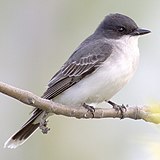 |
A – rare vagrant |
Shrikes
[edit]Order: Passeriformes Family: Laniidae
Shrikes are passerine birds known for their habit of catching other birds and small animals and impaling the uneaten portions of their bodies on thorns. A typical shrike's beak is hooked, like a bird of prey.
| Common and binomial names | Image | Status |
|---|---|---|
| Brown shrike (Lanius cristatus) |
 |
A – rare vagrant |
| Red-backed shrike (Lanius collurio) |
 |
A – scarce passage migrant, occasional breeder |
| Daurian shrike (Lanius isabellinus) |
 |
A – rare vagrant |
| Turkestan shrike (Lanius phoenicuroides) |
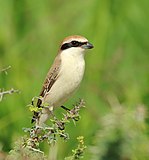 |
A – rare vagrant |
| Long-tailed shrike (Lanius schach) |
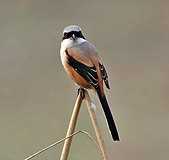 |
A – rare vagrant |
| Lesser grey shrike (Lanius minor) |
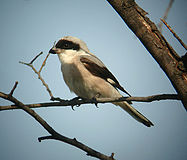 |
A – rare vagrant |
| Great grey shrike (Lanius excubitor) |
 |
A – scarce winter visitor |
| Woodchat shrike (Lanius senator) |
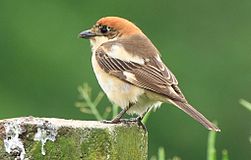 |
A – scarce migrant |
| Masked shrike (Lanius nubicus) |
 |
A – rare vagrant |
Vireos
[edit]Order: Passeriformes Family: Vireonidae
The vireos are a group of small to medium-sized passerine birds restricted to the New World.
| Common and binomial names | Image | Status |
|---|---|---|
| Yellow-throated vireo (Vireo flavifrons) |
 |
A – rare vagrant |
| Philadelphia vireo (Vireo philadelphicus) |
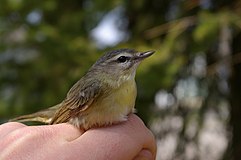 |
A – rare vagrant |
| Red-eyed vireo (Vireo olivaceus) |
 |
A – rare vagrant |
Old World orioles
[edit]Order: Passeriformes Family: Oriolidae
The orioles are medium-sized passerines, mostly with bright and showy plumage, the females often have duller plumage than the males The beak is long, slightly curved and hooked. Orioles are arboreal and tend to feed in the canopy. There are 36 species worldwide, one of which has been recorded in Great Britain.
| Common and binomial names | Image | Status |
|---|---|---|
| Golden oriole (Oriolus oriolus) |
 |
A – scarce breeding summer visitor |
Crows, jays, and magpies
[edit]Order: Passeriformes Family: Corvidae
The crows and their relatives are fairly large birds with strong bills and are usually intelligent and adaptable.
| Common and binomial names | Image | Status |
|---|---|---|
| Jay (Garrulus glandarius) |
 |
A – resident breeding species |
| Magpie (Pica pica) |
 |
A – resident breeding species |
| Nutcracker (Nucifraga caryocatactes) |
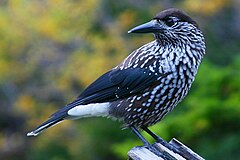 |
A – rare vagrant |
| Chough (Pyrrhocorax pyrrhocorax) |
A – resident breeding species | |
| Jackdaw (Coloeus monedula) |
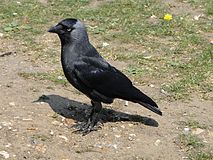 |
A – resident breeding species |
| Rook (Corvus frugilegus) |
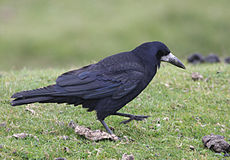 |
A – resident breeding species |
| Carrion crow (Corvus corone) |
 |
A – resident breeding species |
| Hooded crow (Corvus cornix) |
 |
A – resident breeding species |
| Raven (Corvus corax) |
 |
A – resident breeding species |
Waxwings
[edit]Order: Passeriformes Family: Bombycillidae
The waxwings are a group of passerine birds characterised by soft, silky plumage and unique red tips to some of the wing feathers.
| Common and binomial names | Image | Status |
|---|---|---|
| Waxwing (Bombycilla garrulus) |
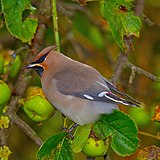 |
A – winter visitor in highly variable numbers |
| Cedar waxwing (Bombycilla cedrorum) |
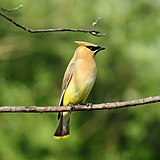 |
A – rare vagrant |
Tits, chickadees, and titmice
[edit]Order: Passeriformes Family: Paridae
Tits are mainly small, stocky, woodland species with short stout bills. They are adaptable birds, with a mixed diet including seeds and insects.
| Common and binomial names | Image | Status |
|---|---|---|
| Coal tit (Periparus ater) |
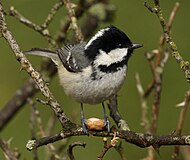 |
A – resident breeding species |
| Crested tit (Lophophanes cristatus) |
 |
A – resident breeding species |
| Marsh tit (Poecile palustris) |
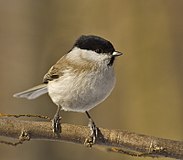 |
A – resident breeding species |
| Willow tit (Poecile montana) |
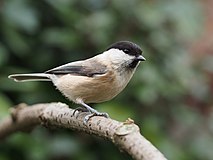 |
A – resident breeding species |
| Blue tit (Cyanistes caeruleus) |
 |
A – resident breeding species |
| Great tit (Parus major) |
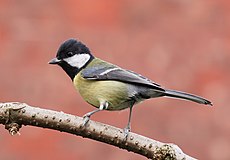 |
A – resident breeding species |
Penduline tits
[edit]Order: Passeriformes Family: Remizidae
Small birds with finely pointed bills that build purse-like nests hanging from a branch.
| Common and binomial names | Image | Status |
|---|---|---|
| Penduline tit (Remiz pendulinus) |
 |
A – rare vagrant |
Bearded tit
[edit]Order: Passeriformes Family: Panuridae
A single species formerly placed in the family Sylviidae.
| Common and binomial names | Image | Status |
|---|---|---|
| Bearded tit (Panurus biarmicus) |
 |
A – resident breeding species |
Larks
[edit]Order: Passeriformes Family: Alaudidae
Larks are small terrestrial birds with often extravagant songs and display flights. Most larks are fairly dull in appearance. Their food is insects and seeds.
| Common and binomial names | Image | Status |
|---|---|---|
| Woodlark (Lullula arborea) |
 |
A – scarce resident breeding species and summer migrant |
| White-winged lark (Alauda leucoptera) |
 |
A – rare vagrant |
| Skylark (Alauda arvensis) |
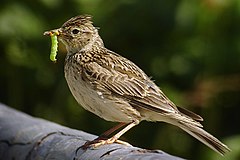 |
A – resident breeding species |
| Crested lark (Galerida cristata) |
 |
A – rare vagrant |
| Shore lark (Eremophila alpestris) |
 |
A – scarce winter visitor and passage migrant, occasional breeder |
| Short-toed lark (Calandrella brachydactyla) |
 |
A – scarce migrant |
| Bimaculated lark (Melanocorypha bimaculata) |
 |
A – rare vagrant |
| Calandra lark (Melanocorypha calandra) |
 |
A – rare vagrant |
| Black lark (Melanocorypha yeltoniensis) |
 |
A – rare vagrant |
Swallows
[edit]Order: Passeriformes Family: Hirundinidae
The family Hirundinidae is adapted to aerial feeding. They have a slender streamlined body, long pointed wings and a short bill with a wide gape.
| Common and binomial names | Image | Status |
|---|---|---|
| Sand martin (Riparia riparia) |
 |
A – breeding summer visitor |
| Tree swallow (Tachycineta bicolor) |
 |
A – rare vagrant |
| Purple martin (Progne subis) |
 |
A – rare vagrant |
| Crag martin (Ptyonoprogne rupestris) |
 |
A – rare vagrant |
| Swallow (Hirundo rustica) |
 |
A – breeding summer visitor |
| House martin (Delichon urbicum) |
 |
A – breeding summer visitor |
| Red-rumped swallow (Cecropis daurica) |
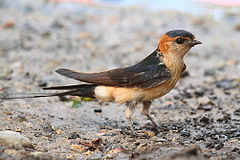 |
A – scarce migrant |
| American cliff swallow (Petrochelidon pyrrhonota) |
 |
A – rare vagrant |
Bush warblers
[edit]Order: Passeriformes Family: Cettiidae
A recently split family formerly placed in the Sylviidae family. There are 32 species worldwide, with one found in Britain.
| Common and binomial names | Image | Status |
|---|---|---|
| Cetti's warbler (Cettia cetti) |
 |
A – recently colonised resident breeding species |
Long-tailed tits
[edit]Order: Passeriformes Family: Aegithalidae
Small, long-tailed birds that typically live in flocks for much of the year. There are 13 species worldwide with one in Britain.
| Common and binomial names | Image | Status |
|---|---|---|
| Long-tailed tit (Aegithalos caudatus) |
 |
A – resident breeding species |
Leaf warblers
[edit]Order: Passeriformes Family: Phylloscopidae
A recently split family of small insectivorous birds, formerly included within the Sylviidae. There are 81 species, with 16 in Britain.
| Common and binomial names | Image | Status |
|---|---|---|
| Wood warbler (Phylloscopus sibilatrix) |
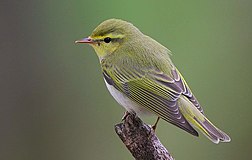 |
A – breeding summer visitor |
| Western Bonelli's warbler (Phylloscopus bonelli) |
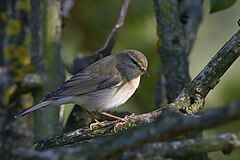 |
A – rare vagrant |
| Eastern Bonelli's warbler (Phylloscopus orientalis) |
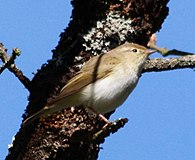 |
A – rare vagrant |
| Hume's warbler (Phylloscopus humei) |
 |
A – rare vagrant |
| Yellow-browed warbler (Phylloscopus inornatus) |
 |
A – scarce migrant |
| Pallas's warbler (Phylloscopus proregulus) |
 |
A – scarce migrant |
| Radde's warbler (Phylloscopus schwarzi) |
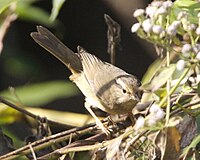 |
A – scarce migrant |
| Sulphur-bellied warbler (Phylloscopus griseolus) |
 |
A – rare vagrant; first reported 2021[21] |
| Dusky warbler (Phylloscopus fuscatus) |
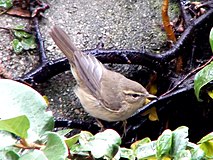 |
A – scarce migrant |
| Willow warbler (Phylloscopus trochilus) |
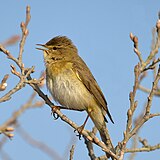 |
A – breeding summer visitor |
| Chiffchaff (Phylloscopus collybita) |
 |
A – breeding summer visitor and passage and winter visitor |
| Iberian chiffchaff (Phylloscopus ibericus) |
 |
A – rare vagrant, occasional breeder |
| Eastern crowned warbler (Phylloscopus coronatus) |
 |
A – rare vagrant |
| Green warbler (Phylloscopus nitidus) |
 |
A – rare vagrant |
| Two-barred greenish warbler (Phylloscopus plumbeitarsus) |
 |
A – rare vagrant |
| Greenish warbler (Phylloscopus trochiloides) |
 |
A – scarce migrant |
| Pale-legged leaf warbler (Phylloscopus tenellipes) |
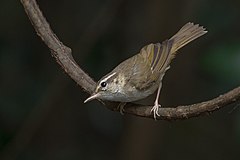 |
A – rare vagrant |
| Arctic warbler (Phylloscopus borealis) |
 |
A – scarce migrant |
Reed warblers
[edit]Order: Passeriformes Family: Acrocephalidae
A small, insectivorous and vocal group of species, formerly included within the family Sylviidae.
| Common and binomial names | Image | Status |
|---|---|---|
| Great reed warbler (Acrocephalus arundinaceus) |
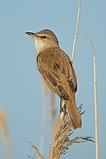 |
A – rare vagrant; has bred |
| Aquatic warbler (Acrocephalus paludicola) |
 |
A – formerly a scarce migrant, now a rare vagrant[9] |
| Sedge warbler (Acrocephalus schoenobaenus) |
 |
A – breeding summer visitor |
| Paddyfield warbler (Acrocephalus agricola) |
 |
A – rare vagrant |
| Blyth's reed warbler (Acrocephalus dumetorum) |
 |
A – formerly a rare vagrant, now a scarce migrant[9] |
| Reed warbler (Acrocephalus scirpaceus) |
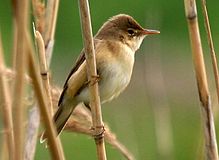 |
A – breeding summer visitor |
| Marsh warbler (Acrocephalus palustris) |
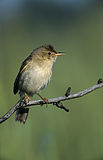 |
A – breeding summer visitor |
| Thick-billed warbler (Arundinax aedon) |
 |
A – rare vagrant |
| Booted warbler (Iduna caligata) |
 |
A – rare vagrant |
| Sykes's warbler (Iduna rama) |
 |
A – rare vagrant |
| Eastern olivaceous warbler (Iduna pallida) |
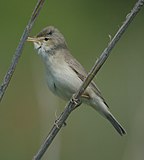 |
A – rare vagrant |
| Western olivaceous warbler (Iduna opaca) |
 |
A – rare vagrant; first recorded in October 2023 |
| Olive-tree warbler (Hippolais olivetorum) |
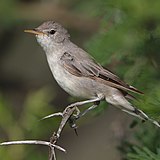 |
A – rare vagrant |
| Melodious warbler (Hippolais polyglotta) |
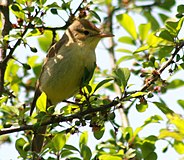 |
A – scarce migrant |
| Icterine warbler (Hippolais icterina) |
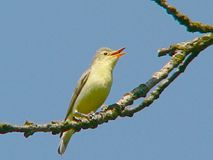 |
A – scarce migrant, occasional breeder |
Grassbirds and allies
[edit]Order: Passeriformes Family: Locustellidae
A recently split family, previously part of the family Sylviidae.
| Common and binomial names | Image | Status |
|---|---|---|
| Pallas's grasshopper warbler (Helopsaltes certhiola) |
 |
A – rare vagrant |
| Lanceolated warbler (Locustella lanceolata) |
 |
A – rare vagrant |
| River warbler (Locustella fluviatilis) |
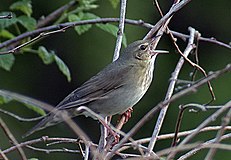 |
A – rare vagrant |
| Savi's warbler (Locustella luscinioides) |
 |
A – rare breeding summer visitor |
| Grasshopper warbler (Locustella naevia) |
 |
A – breeding summer visitor |
Cisticolas and allies
[edit]Order: Passeriformes Family: Cisticolidae
A group of insectivorous species, previously included within the family Sylviidae.
| Common and binomial names | Image | Status |
|---|---|---|
| Fan-tailed warbler (Cisticola juncidis) |
 |
A – rare vagrant |
Sylviid warblers, parrotbills, and allies
[edit]Order: Passeriformes Family: Sylviidae
A group of small insectivorous birds.
| Common and binomial names | Image | Status |
|---|---|---|
| Blackcap (Sylvia atricapilla) |
 |
A – resident breeding species and summer visitor |
| Garden warbler (Sylvia borin) |
 |
A – breeding summer visitor |
| Barred warbler (Curruca nisoria) |
 |
A – passage migrant |
| Lesser whitethroat (Curruca curruca) |
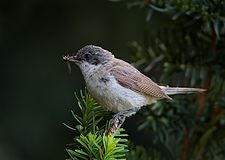 |
A – breeding summer visitor |
| Western Orphean warbler (Curucca hortensis) |
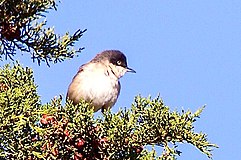 |
A – rare vagrant |
| Eastern Orphean warbler (Curucca crassirostris) |
 |
A – rare vagrant |
| Asian desert warbler (Curruca nana) |
 |
A – rare vagrant |
| Rüppell's warbler (Curruca ruppeli) |
 |
A – rare vagrant |
| Sardinian warbler (Curruca melanocephala) |
 |
A – rare vagrant |
| Western subalpine warbler (Curruca iberiae) |
 |
A – rare vagrant |
| Moltoni's subalpine warbler (Curruca subalpina) |
 |
A – rare vagrant |
| Eastern subalpine warbler (Curruca cantillans) |
 |
A – rare vagrant |
| Whitethroat (Curruca communis) |
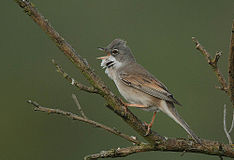 |
A – breeding summer visitor |
| Spectacled warbler (Curruca conspicillata) |
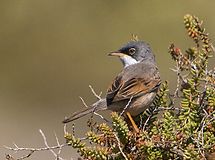 |
A – rare vagrant |
| Marmora's warbler (Curruca sarda) |
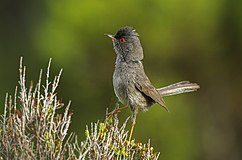 |
A – rare vagrant |
| Dartford warbler (Curruca undata) |
 |
A – resident breeding species |
Kinglets
[edit]Order: Passeriformes Family: Regulidae
A family of very small birds.
| Common and binomial names | Image | Status |
|---|---|---|
| Ruby-crowned kinglet (Corthylio calendula) |
 |
A – rare vagrant; first recorded 2020[22] |
| Goldcrest (Regulus regulus) |
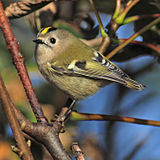 |
A – resident breeding species |
| Firecrest (Regulus ignicapillus) |
 |
A – scarce resident breeding species and passage migrant |
Wrens
[edit]Order: Passeriformes Family: Troglodytidae
Wrens are small and inconspicuous birds, except for their loud songs. They have short wings and thin down-turned bills.
| Common and binomial names | Image | Status |
|---|---|---|
| Wren (Troglodytes troglodytes) |
 |
A – resident breeding species |
Nuthatches
[edit]Order: Passeriformes Family: Sittidae
Nuthatches are small woodland birds with the unusual ability to climb down trees head-first, unlike other birds which can only go upwards.
| Common and binomial names | Image | Status |
|---|---|---|
| Red-breasted nuthatch (Sitta canadensis) |
 |
A – rare vagrant |
| Nuthatch (Sitta europaea) |
 |
A – resident breeding species |
Wallcreeper
[edit]Order: Passeriformes Family: Tichodromadidae
One species, in its own family, a rare visitor to Britain.
| Common and binomial names | Image | Status |
|---|---|---|
| Wallcreeper (Tichodroma muraria) |
 |
A – rare vagrant |
Treecreepers
[edit]Order: Passeriformes Family: Certhiidae
Treecreepers are small woodland birds, brown above and white below. They have thin, pointed, down-curved bills, which they use to extricate insects from bark.
| Common and binomial names | Image | Status |
|---|---|---|
| Treecreeper (Certhia familiaris) |
 |
A – resident breeding species |
| Short-toed treecreeper (Certhia brachydactyla) |
 |
A – rare vagrant |
Mockingbirds and thrashers
[edit]Order: Passeriformes Family: Mimidae
Medium-sized passerine birds with long tails. Some are notable for their ability to mimic sounds such as other birds' songs.
| Common and binomial names | Image | Status |
|---|---|---|
| Grey catbird (Dumetella carolinensis) |
 |
A – rare vagrant (two records) |
| Northern mockingbird (Mimus polyglottos) |
 |
A – rare vagrant |
| Brown thrasher (Toxostoma rufum) |
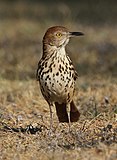 |
A – rare vagrant (one record) |
Starlings
[edit]Order: Passeriformes Family: Sturnidae
Starlings are small to medium-sized passerine birds with strong feet. Their flight is strong and direct and most are very gregarious.
| Common and binomial names | Image | Status |
|---|---|---|
| Rose-coloured starling (Pastor roseus) |
 |
A – rare vagrant |
| Starling (Sturnus vulgaris) |
 |
A – resident breeding species and winter visitor |
Thrushes and allies
[edit]Order: Passeriformes Family: Turdidae
The thrushes are plump, soft-plumaged, small to medium-sized insectivores or sometimes omnivores, often feeding on the ground. Many have attractive songs.
| Common and binomial names | Image | Status |
|---|---|---|
| Varied thrush (Ixoreus naevius) |
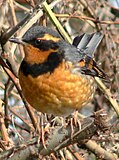 |
A – very rare vagrant (two records as of 2023[update]) |
| Wood thrush (Hylocichla mustelina) |
 |
A – rare vagrant |
| Swainson's thrush (Catharus ustulatus) |
 |
A – rare vagrant |
| Hermit thrush (Catharus guttatus) |
 |
A – rare vagrant |
| Grey-cheeked thrush (Catharus minimus) |
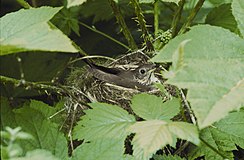 |
A – rare vagrant |
| Veery (Catharus fuscescens) |
 |
A – rare vagrant |
| White's thrush (Zoothera dauma) |
 |
A – rare vagrant |
| Siberian thrush (Geokichla sibirica) |
 |
A – rare vagrant |
| Song thrush (Turdus philomelos) |
 |
A – resident breeding species |
| Mistle thrush (Turdus viscivorus) |
 |
A – resident breeding species |
| Redwing (Turdus iliacus) |
 |
A – winter visitor, rare breeder; two subspecies:
|
| Blackbird (Turdus merula) |
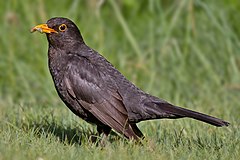 |
A – resident breeding species |
| Eyebrowed thrush (Turdus obscurus) |
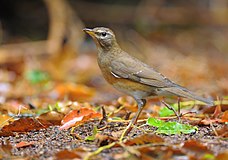 |
A – rare vagrant |
| Fieldfare (Turdus pilaris) |
 |
A – winter visitor, rare breeder |
| Ring ouzel (Turdus torquatus) |
 |
A – breeding summer visitor |
| Black-throated thrush (Turdus atrogularis) |
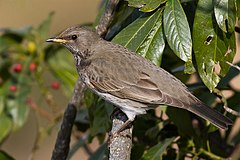 |
A – rare vagrant |
| Red-throated thrush (Turdus ruficollis) |
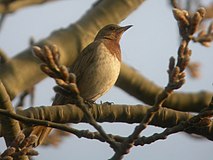 |
A – rare vagrant |
| Dusky thrush (Turdus eunomus) |
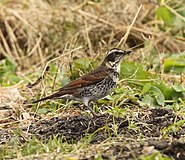 |
A – rare vagrant |
| Naumann's thrush (Turdus naumanni) |
 |
A – rare vagrant |
| American robin (Turdus migratorius) |
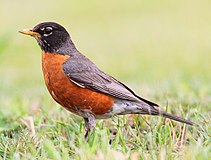 |
A – rare vagrant |
Old World flycatchers
[edit]Order: Passeriformes Family: Muscicapidae. Subfamily: Muscicapinae
The flycatchers and chats are small, mainly insectivorous birds. The flycatchers fly out from a perch to catch insects in the air.
| Common and binomial names | Image | Status |
|---|---|---|
| Rufous-tailed scrub robin (Cercotrichas galactotes) |
 |
A – rare vagrant |
| Spotted flycatcher (Muscicapa striata) |
 |
A – breeding summer visitor |
| Asian brown flycatcher (Muscicapa dauurica) |
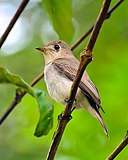 |
A – rare vagrant |
| Robin (Erithacus rubecula) |
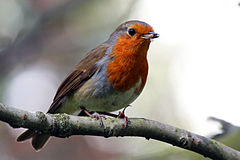 |
A – resident breeding species |
| Siberian blue robin (Larvivora cyanea) |
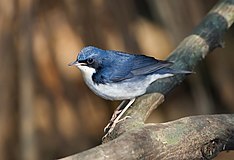 |
A – rare vagrant |
| Rufous-tailed robin (Larvivora sibilans) |
 |
A – rare vagrant |
| Bluethroat (Luscinia svecica) |
 |
A – scarce migrant, occasional breeder; two subspecies:
|
| Thrush nightingale (Luscinia luscinia) |
 |
A – rare vagrant |
| Nightingale (Luscinia megarhynchos) |
 |
A – breeding summer visitor |
| White-throated robin (Irania gutturalis) |
 |
A – rare vagrant |
| Siberian rubythroat (Calliope calliope) |
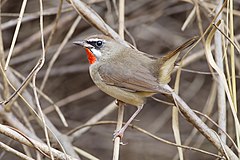 |
A – rare vagrant |
| Red-flanked bluetail (Tarsiger cyanurus) |
 |
A – scarce migrant, formerly a rare vagrant[9] |
| Taiga flycatcher (Ficedula albicilla) |
 |
A – rare vagrant |
| Red-breasted flycatcher (Ficedula parva) |
 |
A – scarce migrant |
| Pied flycatcher (Ficedula hypoleuca) |
 |
A – breeding summer visitor |
| Collared flycatcher (Ficedula albicollis) |
 |
A – rare vagrant |
| Black redstart (Phoenicurus ochruros) |
 |
A – scarce breeding resident, passage migrant and winter visitor |
| Redstart (Phoenicurus phoenicurus) |
 |
A – breeding summer visitor |
| Moussier's redstart (Phoenicurus moussieri) |
 |
A – rare vagrant |
| Rock thrush (Monticola saxatilis) |
 |
A – rare vagrant |
| Blue rock thrush (Monticola solitarius) |
 |
A – rare vagrant |
| Whinchat (Saxicola rubetra) |
 |
A – breeding summer visitor and passage migrant |
| Stonechat (Saxicola rubicola) |
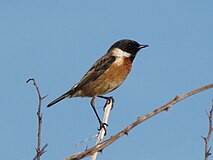 |
A – resident breeding species |
| Siberian stonechat (Saxicola maurus) |
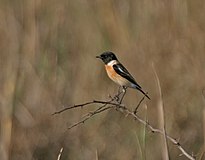 |
A – rare vagrant |
| Stejneger's stonechat (Saxicola stejnegeri) |
 |
A – rare vagrant |
| Wheatear (Oenanthe oenanthe) |
 |
A – breeding summer visitor and passage migrant |
| Isabelline wheatear (Oenanthe isabellina) |
 |
A – rare vagrant |
| Desert wheatear (Oenanthe deserti) |
 |
A – rare vagrant |
| Western black-eared wheatear (Oenanthe hispanica) |
 |
A – rare vagrant |
| Eastern black-eared wheatear (Oenanthe melanoleuca) |
 |
A – rare vagrant |
| Pied wheatear (Oenanthe pleschanka) |
 |
A – rare vagrant |
| White-crowned black wheatear (Oenanthe leucopyga) |
 |
A – rare vagrant |
Dippers
[edit]Order: Passeriformes Family: Cinclidae
Dark, dumpy, aquatic birds which are able to forage for food on the beds of rivers.
| Common and binomial names | Image | Status |
|---|---|---|
| Dipper (Cinclus cinclus) |
 |
A – resident breeding species |
Old World sparrows
[edit]Order: Passeriformes Family: Passeridae
Sparrows tend to be small, plump, brownish or greyish birds with short tails and short, powerful beaks. They are seed-eaters and they also consume small insects.
| Common and binomial names | Image | Status |
|---|---|---|
| Rock sparrow (Petronia petronia) |
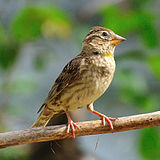 |
A – rare vagrant |
| Tree sparrow (Passer montanus) |
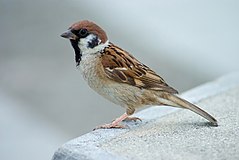 |
A – resident breeding species |
| Spanish sparrow (Passer hispaniolensis) |
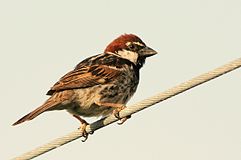 |
A – rare vagrant |
| House sparrow (Passer domesticus) |
 |
A – resident breeding species |
Accentors
[edit]Order: Passeriformes Family: Prunellidae
A small family of drab, unobtrusive, insectivorous birds with thin, pointed bills.
| Common and binomial names | Image | Status |
|---|---|---|
| Alpine accentor (Prunella collaris) |
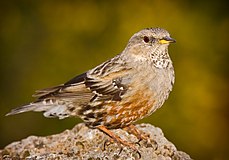 |
A – rare vagrant |
| Siberian accentor (Prunella montanella) |
 |
A – rare vagrant with multiple records in 2016 |
| Dunnock (Prunella modularis) |
 |
A – resident breeding species |
Wagtails and pipits
[edit]Order: Passeriformes Family: Motacillidae
Motacillidae is a family of small passerine birds with medium to long tails. They are slender, ground-feeding insectivores of open country.
| Common and binomial names | Image | Status |
|---|---|---|
| Yellow wagtail (Motacilla flava) |
 |
Six subspecies:
|
| Eastern yellow wagtail (Motacilla tschutschensis) |
 |
A – rare vagrant |
| Citrine wagtail (Motacilla citreola) |
 |
A – scarce migrant, formerly a rare vagrant[9] |
| Grey wagtail (Motacilla cinerea) |
 |
A – resident breeding species |
| Pied wagtail (Motacilla alba) |
 |
A – resident breeding species with three additional visiting subspecies
|
| Richard's pipit (Anthus richardi) |
 |
A – scarce migrant |
| Blyth's pipit (Anthus godlewskii) |
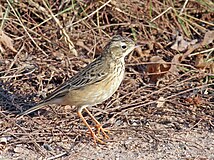 |
A – rare vagrant |
| Tawny pipit (Anthus campestris) |
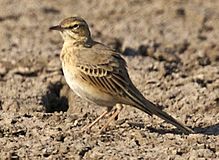 |
A – rare vagrant, formerly a scarce migrant[9] |
| Meadow pipit (Anthus pratensis) |
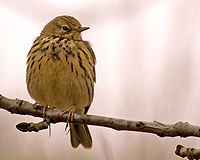 |
A – resident breeding species |
| Tree pipit (Anthus trivialis) |
 |
A – breeding summer visitor |
| Olive-backed pipit (Anthus hodgsoni) |
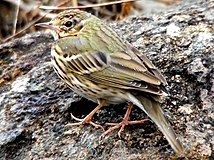 |
A – rare vagrant |
| Pechora pipit (Anthus gustavi) |
 |
A – rare vagrant |
| Red-throated pipit (Anthus cervinus) |
 |
A – rare vagrant, formerly a scarce migrant[9] |
| Buff-bellied pipit (Anthus rubescens) |
 |
A – rare vagrant |
| Water pipit (Anthus spinoletta) |
 |
A – winter visitor |
| Rock pipit (Anthus petrosus) |
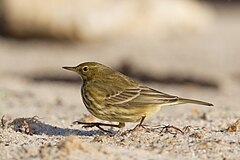 |
A – resident breeding species |
Finches, euphonias, and allies
[edit]Order: Passeriformes Family: Fringillidae
Seed-eating passerine birds that are small to moderately large and have a strong beak, usually conical and in some species very large.
| Common and binomial names | Image | Status |
|---|---|---|
| Chaffinch (Fringilla coelebs) |
 |
A – resident breeding species |
| Brambling (Fringilla montifringilla) |
 |
A – winter visitor, occasional breeder |
| Evening grosbeak (Hesperiphona vespertina) |
 |
A – rare vagrant |
| Hawfinch (Coccothraustes coccothraustes) |
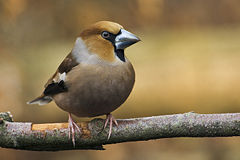 |
A – scarce resident breeding species |
| Pine grosbeak (Pinicola enucleator) |
 |
A – rare vagrant |
| Bullfinch (Pyrrhula pyrrhula) |
 |
A – resident breeding species |
| Trumpeter finch (Bucanetes githagineus) |
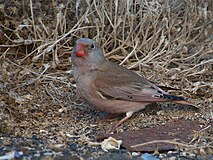 |
A – rare vagrant |
| Common rosefinch (Carpodacus erythrinus) |
 |
A – scarce migrant, occasional breeder |
| Greenfinch (Chloris chloris) |
 |
A – resident breeding species |
| Twite (Linaria flavirostris) |
 |
A – resident breeding species |
| Linnet (Linaria cannabina) |
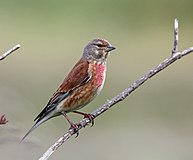 |
A – resident breeding species |
| Common redpoll (Acanthis flammea) |
 |
A – winter visitor and passage migrant, occasional breeder |
| Lesser redpoll (Acanthis cabaret) |
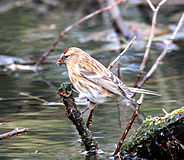 |
A – resident breeding species |
| Arctic redpoll (Acanthis hornemanni) |
 |
A – rare vagrant, formerly a scarce migrant[9] |
| Parrot crossbill (Loxia pytyopsittacus) |
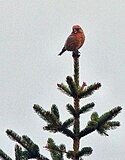 |
A – resident breeding species |
| Scottish crossbill (Loxia scotica) |
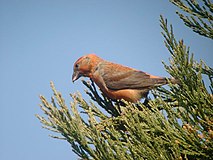 |
A – resident endemic breeding species |
| Crossbill (Loxia curvirostra) |
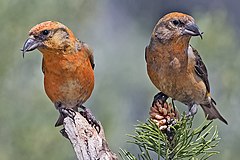 |
A – resident breeding species |
| Two-barred crossbill (Loxia leucoptera) |
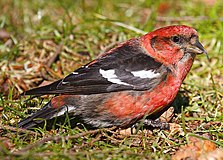 |
A – rare vagrant |
| Goldfinch (Carduelis carduelis) |
 |
A – resident breeding species |
| Citril finch (Carduelis citrinella) |
 |
A – rare vagrant |
| Serin (Serinus serinus) |
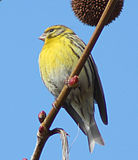 |
A – scarce passage migrant, occasional breeder |
| Siskin (Spinus spinus) |
 |
A – resident breeding species and winter visitor |
Longspurs and arctic buntings
[edit]Order: Passeriformes Family: Calcariidae
A small family of migratory seed eating birds.
| Common and binomial names | Image | Status |
|---|---|---|
| Lapland bunting (Calcarius lapponicus) |
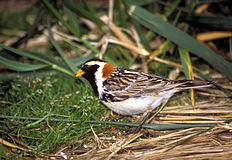 |
A – winter visitor, occasional breeder |
| Snow bunting (Plectrophenax nivalis) |
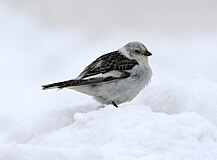 |
A – winter visitor and scarce breeder |
Old World buntings
[edit]Order: Passeriformes Family: Emberizidae. A large group of seed-eating passerine birds with a distinctively shaped bill.
| Common and binomial names | Image | Status |
|---|---|---|
| Corn bunting (Emberiza calandra) |
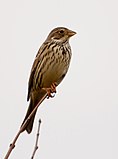 |
A – resident breeding species |
| Yellowhammer (Emberiza citrinella) |
 |
A – resident breeding species |
| Pine bunting (Emberiza leucocephalos) |
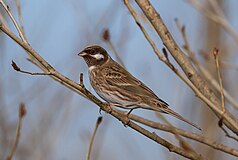 |
A – rare vagrant |
| Rock bunting (Emberiza cia) |
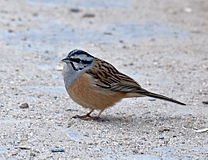 |
A – rare vagrant |
| Ortolan bunting (Emberiza hortulana) |
 |
A – scarce migrant |
| Cretzschmar's bunting (Emberiza caesia) |
 |
A – rare vagrant |
| Cirl bunting (Emberiza cirlus) |
 |
A – resident breeding species |
| Chestnut-eared bunting (Emberiza fucata) |
 |
A – rare vagrant |
| Little bunting (Emberiza pusilla) |
 |
A – scarce migrant |
| Yellow-browed bunting (Emberiza chrysophrys) |
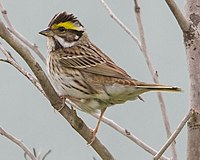 |
A – rare vagrant |
| Rustic bunting (Emberiza rustica) |
 |
A – rare vagrant, formerly a scarce migrant[9] |
| Yellow-breasted bunting (Emberiza aureola) |
 |
A – rare vagrant |
| Chestnut bunting (Emberiza rutila) |
 |
A – rare vagrant |
| Black-headed bunting (Emberiza melanocephala) |
 |
A – rare vagrant |
| Red-headed bunting (Emberiza bruniceps) |
 |
A – rare vagrant |
| Black-faced bunting (Emberiza spodocephala) |
 |
A – rare vagrant |
| Pallas's reed bunting (Emberiza pallasi) |
 |
A – rare vagrant |
| Reed bunting (Emberiza schoeniclus) |
 |
A – resident breeding species |
New World sparrows
[edit]Order: Passeriformes Family: Passerellidae.
A seed eating group of species, recently split from the family Emberizidae.
| Common and binomial names | Image | Status |
|---|---|---|
| Lark sparrow (Chondestes grammacus) |
 |
A – rare vagrant |
| Dark-eyed junco (junco hyemalis) |
 |
A – rare vagrant |
| White-crowned sparrow (Zonotrichia leucophrys) |
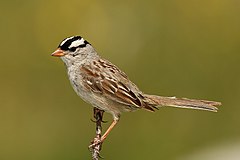 |
A – rare vagrant |
| White-throated sparrow (Zonotrichia albicollis) |
 |
A – rare vagrant |
| Savannah sparrow (Passerculus sandwichensis) |
 |
A – rare vagrant |
| Song sparrow (Melospiza melodia) |
 |
A – rare vagrant |
| Eastern towhee (Pipilo erythrophthalmus) |
 |
A – rare vagrant |
Troupials and allies
[edit]Order: Passeriformes Family: Icteridae.
The icterids are a group of small to medium-sized, often colorful passerine birds restricted to the New World and include the grackles, New World blackbirds, and New World orioles. Most species have black as a predominant plumage color, often enlivened by yellow, orange, or red.
| Common and binomial names | Image | Status |
|---|---|---|
| Bobolink (Dolichonyx oryzivorus) |
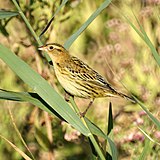 |
A – rare vagrant |
| Baltimore oriole (Icterus galbula) |
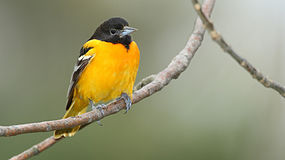 |
A – rare vagrant |
| Red-winged blackbird (Agelaius phoeniceus) |
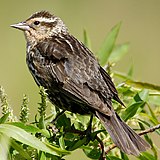 |
A – rare vagrant |
| Brown-headed cowbird (Molothrus ater) |
 |
A – rare vagrant |
New World warblers
[edit]Order: Passeriformes Family: Parulidae
A group of small, often colourful passerine birds restricted to the New World. Most are arboreal and insectivorous.
| Common and binomial names | Image | Status |
|---|---|---|
| Ovenbird (Seiurus aurocapilla) |
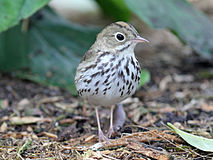 |
A – rare vagrant |
| Northern waterthrush (Parkesia noveboracensis) |
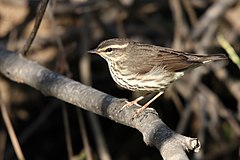 |
A – rare vagrant |
| Golden-winged warbler (Vermivora chrysoptera) |
 |
A – rare vagrant |
| Black-and-white warbler (Mniotilta varia) |
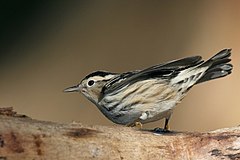 |
A – rare vagrant |
| Tennessee warbler (Leiothlypis peregrina) |
 |
A – rare vagrant |
| Common yellowthroat (Geothlypis trichas) |
 |
A – rare vagrant |
| Hooded warbler (Setophaga citrina) |
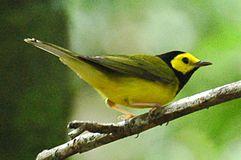 |
A – rare vagrant |
| American redstart (Setophaga ruticilla) |
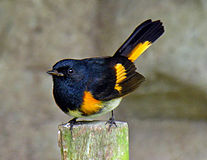 |
A – rare vagrant |
| Cape May warbler (Setophaga tigrina) |
 |
A – rare vagrant |
| Northern parula (Setophaga americana) |
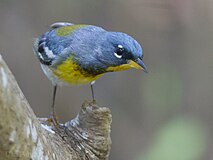 |
A – rare vagrant |
| Magnolia warbler (Setophaga magnolia) |
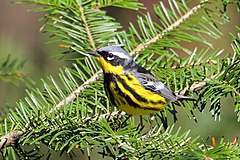 |
A – rare vagrant |
| Bay-breasted warbler (Setophaga castanea) |
 |
A – rare vagrant |
| Blackburnian warbler (Setophaga fusca) |
 |
A – rare vagrant |
| Yellow warbler (Setophaga petechia) |
 |
A – rare vagrant |
| Chestnut-sided warbler (Setophaga pensylvanica) |
 |
A – rare vagrant |
| Blackpoll warbler (Setophaga striata) |
 |
A – rare vagrant |
| Yellow-rumped warbler (Setophaga coronata) |
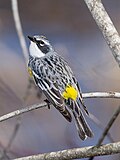 |
A – rare vagrant |
| Canada warbler (Cardellina canadensis) |
 |
A – rare vagrant, one record |
| Wilson's warbler (Cardellina pusilla) |
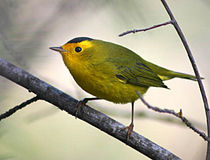 |
A – rare vagrant |
Cardinals and allies
[edit]Order: Passeriformes Family: Cardinalidae
The cardinals are a family of robust, seed-eating birds with strong bills. They are typically associated with open woodland. The sexes usually have distinct plumages.
| Common and binomial names | Image | Status |
|---|---|---|
| Summer tanager (Piranga rubra) |
 |
A – rare vagrant |
| Scarlet tanager (Piranga olivacea) |
 |
A – rare vagrant |
| Rose-breasted grosbeak (Pheucticus ludovicianus) |
 |
A – rare vagrant |
| Indigo bunting (Passerina cyanea) |
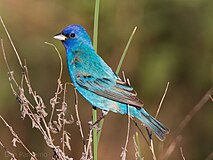 |
A – rare vagrant |
The links above lead to family accounts and individual species. Taxonomy is very fluid in the age of DNA analysis, so other arrangements may be found, as in Sibley-Ahlquist taxonomy.
Species awaiting acceptance
[edit]The following species have been recorded recently and the British Ornithologists' Union Records Committee has not yet made a decision on whether to accept them onto the British List.
| Common and binomial names | Image | Status |
|---|---|---|
| Fea's petrel (Pterodroma feae) |
 |
A – rare vagrant, previously accepted onto the British list as Fea's petrel but since split into three distinct species |
| Grey-headed lapwing (Vanellus cinereus) |
 |
A – rare vagrant; first recorded 2023[23] |
| Canada warbler (Cardellina canadensis) |
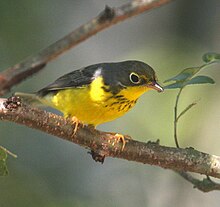
|
A – rare vagrant; first recorded 2023[24] |
See also
[edit]- List of non-native birds of Great Britain
- List of birds of Leicestershire and Rutland
- List of birds of Wales
- Lists of birds by region
- British Birds Rarities Committee
- British Birds (a long-established ornithology journal).
- European birds
- Eurasian eagle-owl in Great Britain
References
[edit]- ^ British Ornithologists' Union (2013). "The British List". Ibis. 155: 635–676. doi:10.1111/ibi.12069.
- ^ "Maintaining the British List". BOU. Retrieved 4 May 2020.
- ^ BOURC. "Species categories". Retrieved 9 December 2012.
- ^ Dudley, Steve P. "Changes to the British List (13 August 2024)". British Ornithologists' Union. Retrieved 13 August 2024.
- ^ "Ross's Goose added to Category A of British list". Birdguides. 29 November 2021. Retrieved 2 December 2021.
- ^ "Stejneger's Scoter added to the British List". Rare Bird Alert. Retrieved 19 February 2024.
- ^ British Ornithologists’ Union Records Committee. "Changes to the British List (21 May 2024)". BOU. Retrieved 23 June 2024.
- ^ Harvey, Robert (2018). "Western Swamphen in Suffolk and Lincolnshire:new to Britain". British Birds. 111 (9): 512–514.
- ^ a b c d e f g h i j "BBRC Species". BBRC. Retrieved 10 October 2023.
- ^ "Kelp gull first sighting in UK is 'extraordinary'". BBC News. Retrieved 3 December 2022.
- ^ a b "Changes to the British List". British Ornithologists' Union. 19 September 2023. Retrieved 10 October 2023.
- ^ "Yellow-legged Gull". BTO. Retrieved 2 August 2023.
...including a small number of breeding pairs along the south coast
- ^ "South Polar Skua added to British list". Birdguides. 21 August 2021. Retrieved 2 December 2021.
- ^ "Zino's Petrel of Scilly – a first for Britain". BirdGuides. 4 August 2020. Retrieved 5 August 2020.
- ^ "Changes to the British List (17 June 2022)". BOURC. 17 June 2022. Retrieved 2 August 2023.
- ^ "Changes to the British List (8 June 2021)". British Ornithologists' Union. 8 June 2021. Retrieved 8 June 2021.
- ^ Hutchinson, Steve (13 September 2023). "Glossy Ibis breeds in Britain for first time". BirdGuides. Retrieved 13 October 2023.
- ^ Viles, Sam (10 October 2022). "Review of the Week: 3-9 October 2022". BirdGuides. Retrieved 10 October 2022.
- ^ "Dalmatian pelican seen 'for first time' in UK at Land's End". BBC News. 11 May 2016. Retrieved 11 September 2020.
- ^ "Yellow-bellied Flycatcher on Tiree". BirdGuides. 25 September 2020. Retrieved 8 December 2020.
- ^ "Sulphur-bellied Warbler in Devon". BirdGuides. 22 June 2021. Retrieved 7 July 2021.
- ^ "First Ruby-crowned Kinglet for Britain on Barra". BirdGuides. 23 November 2020. Retrieved 18 January 2021.
- ^ "Grey-headed lapwing: Sighting in Northumberland is UK first". BBC News. 2 May 2023. Retrieved 20 June 2023.
- ^ Weston, Phoebe (25 September 2023). "'In total shock': birdwatchers amazed as 'uber-rare' American birds land in UK". The Guardian. ISSN 0261-3077. Retrieved 27 September 2023.
External links
[edit]- List of British birds published by The British Ornithologists' Union.
- Taxonomic Recommendations for European Birds
- Taxonomic recommendations for British birds (both in PDF format).
- The Royal Society for the Protection of Birds (RSPB) and RSPB A to Z of UK Birds
- Splitting headaches? Recent taxonomic changes affecting the British and Western Palaearctic lists – Martin Collinson, British Birds vol 99 (June 2006), 306–323
- British Trust for Ornithology surveys

